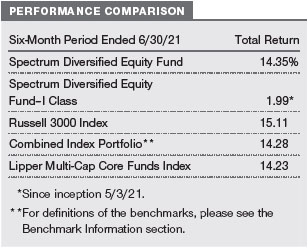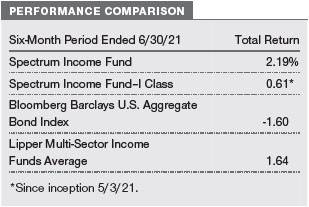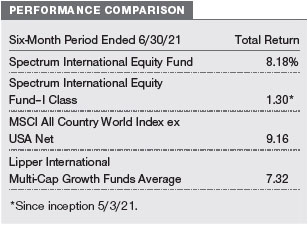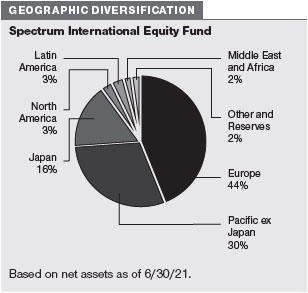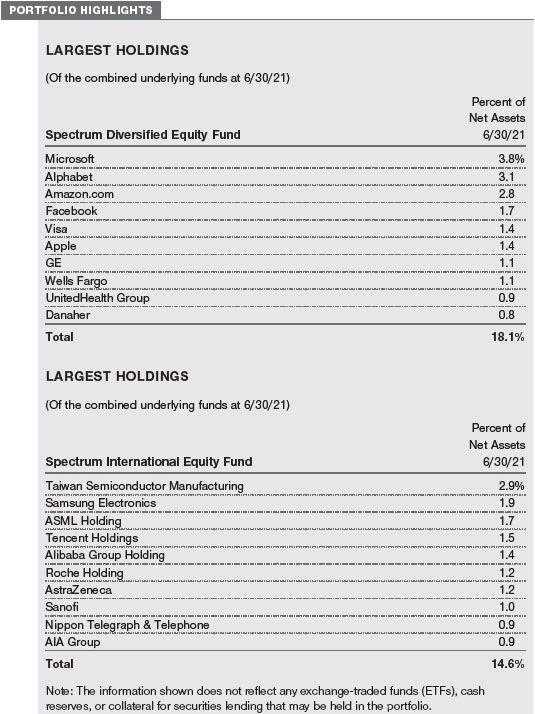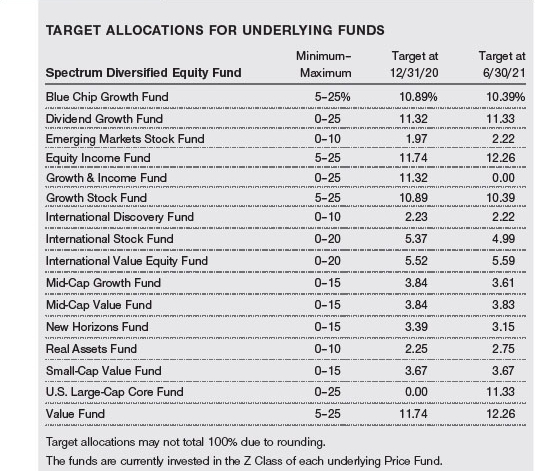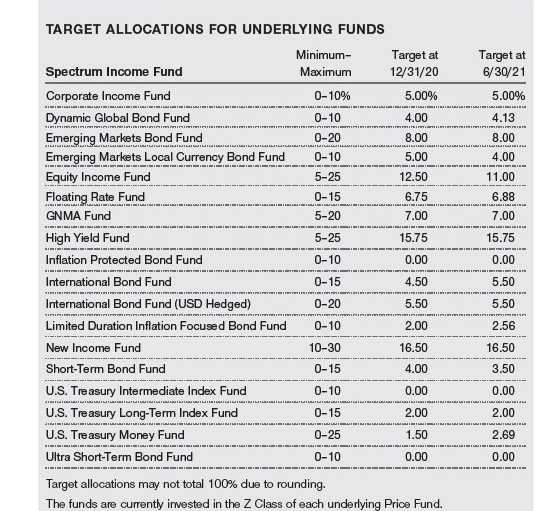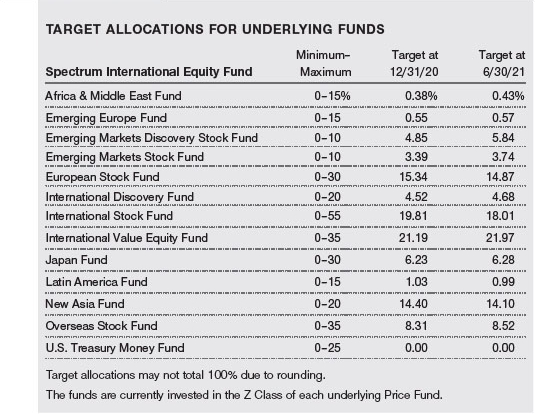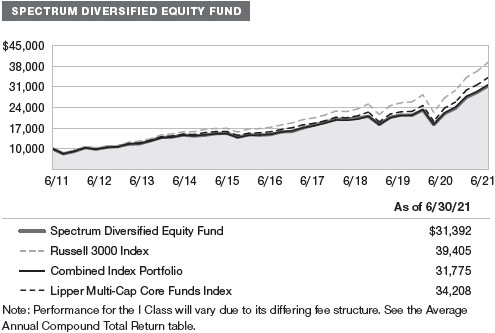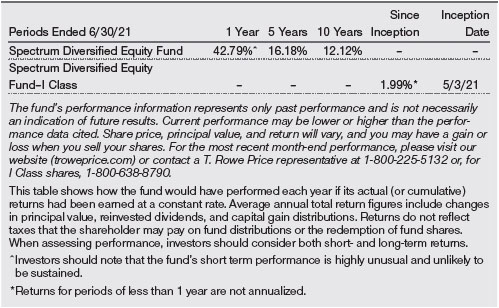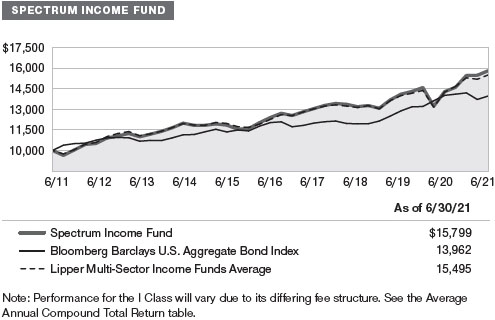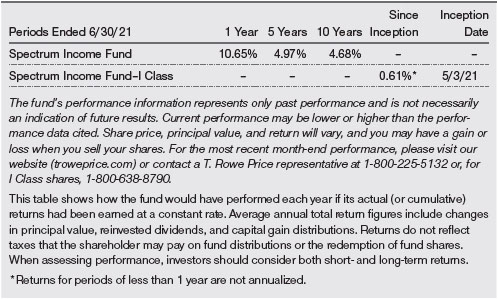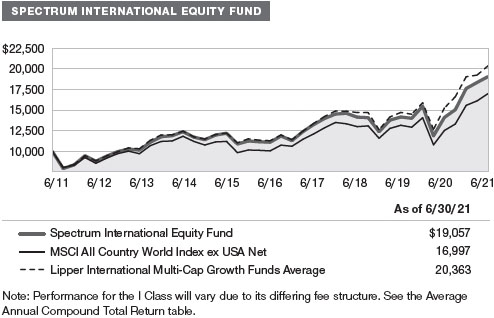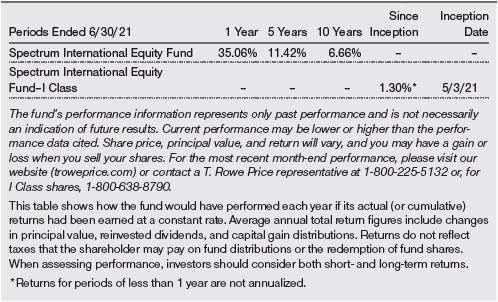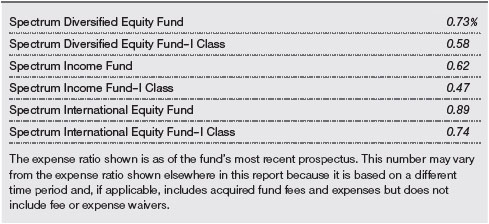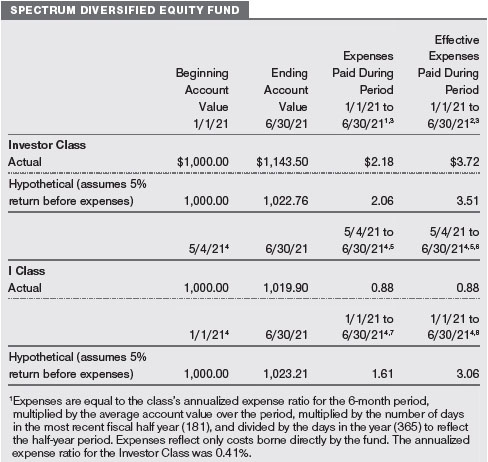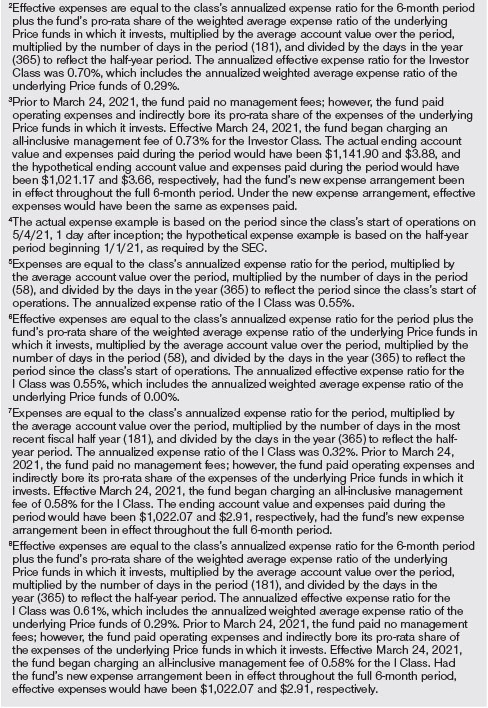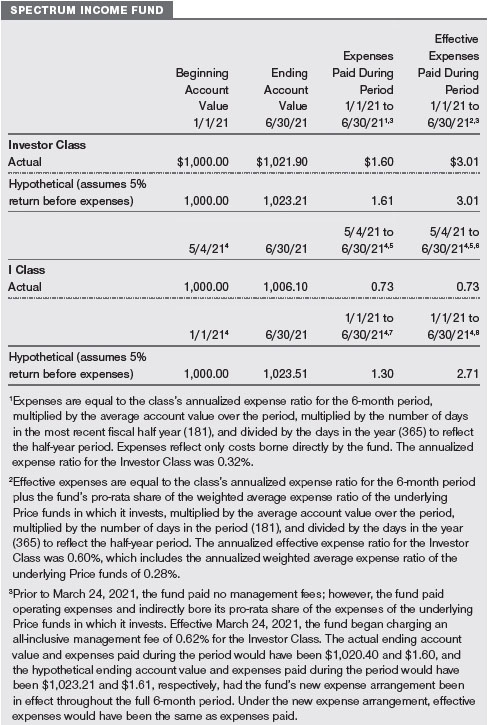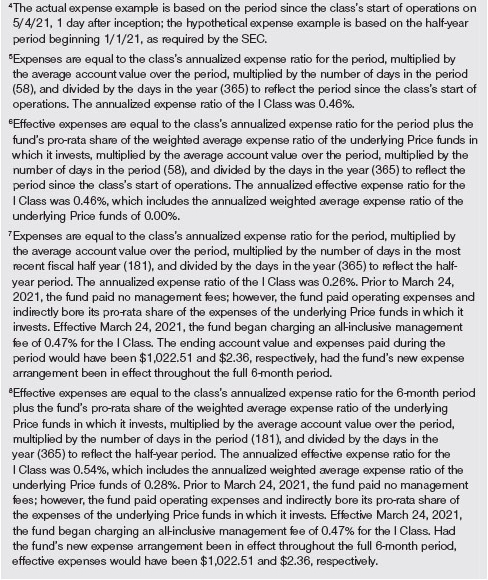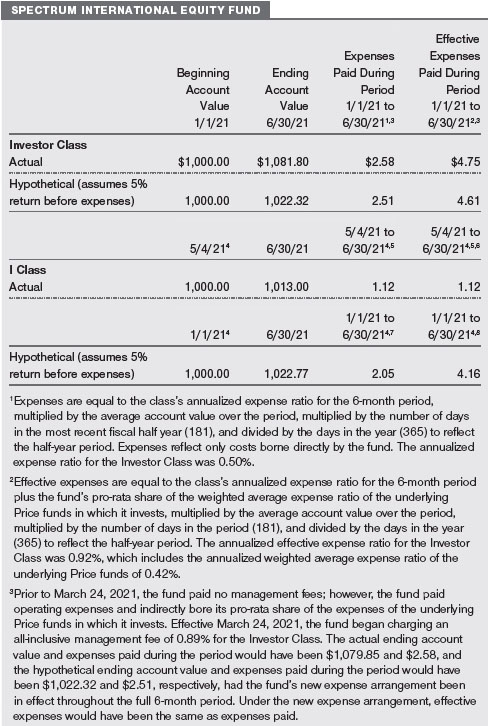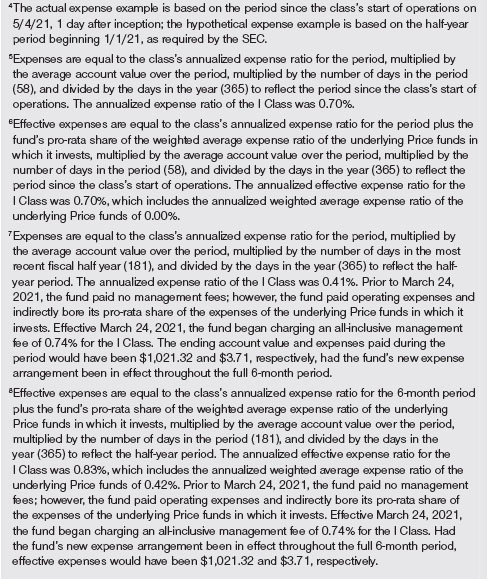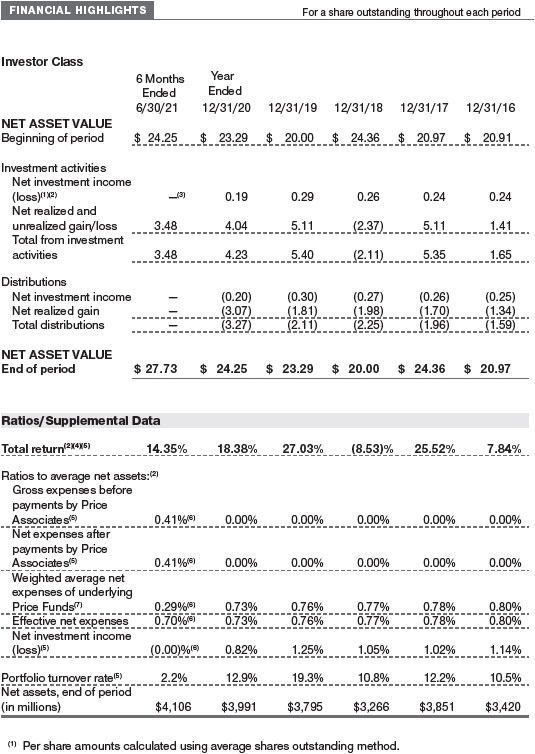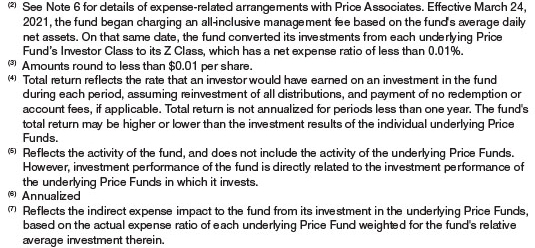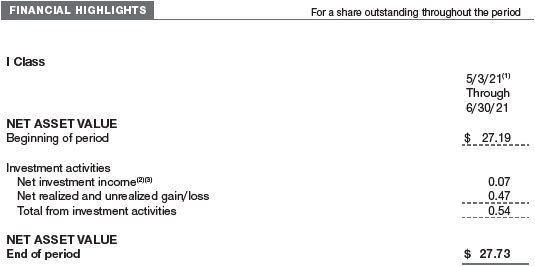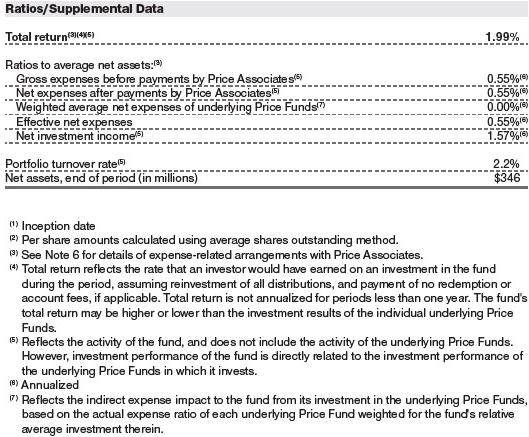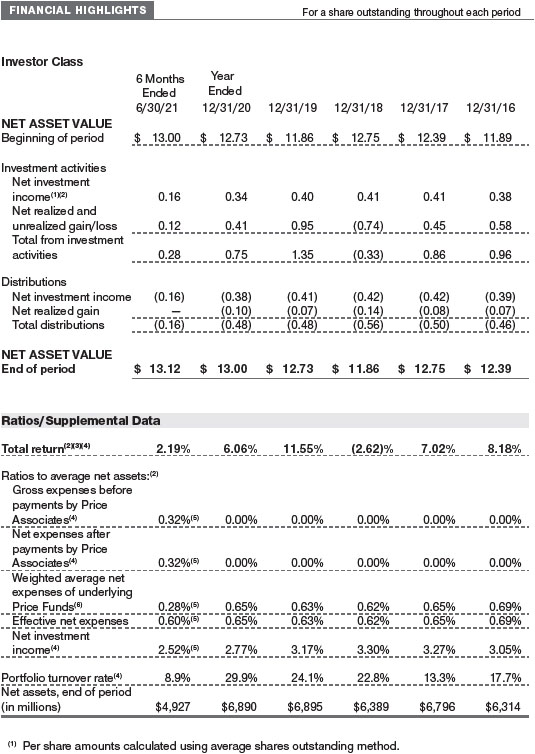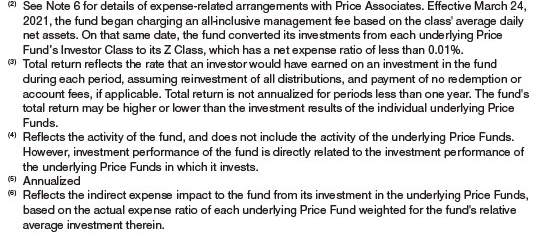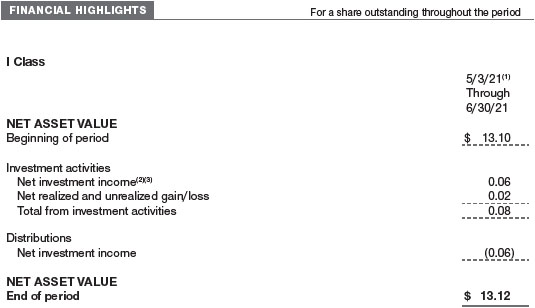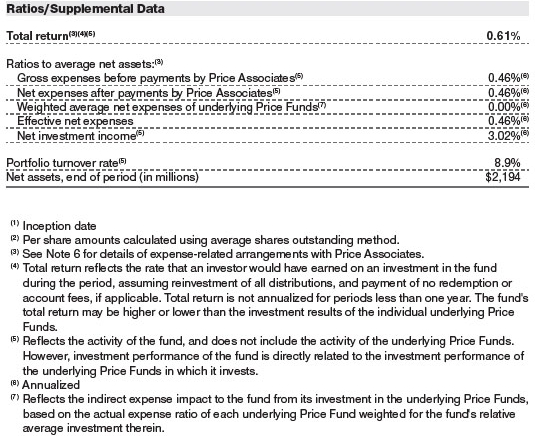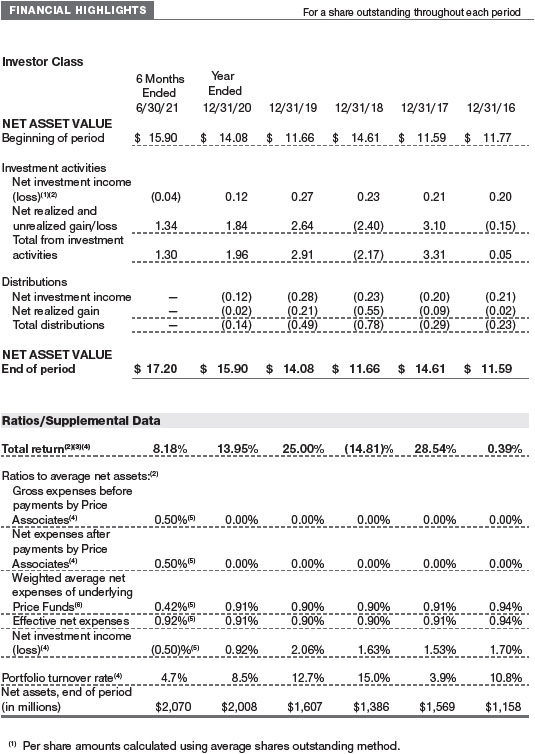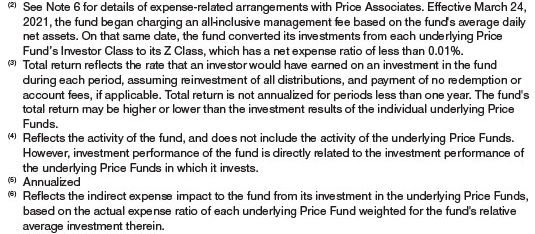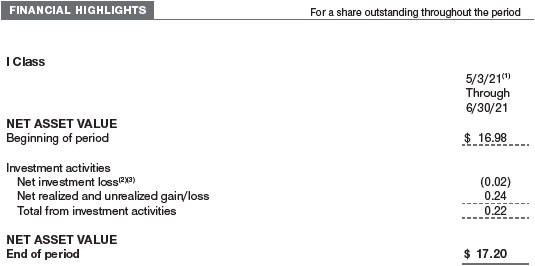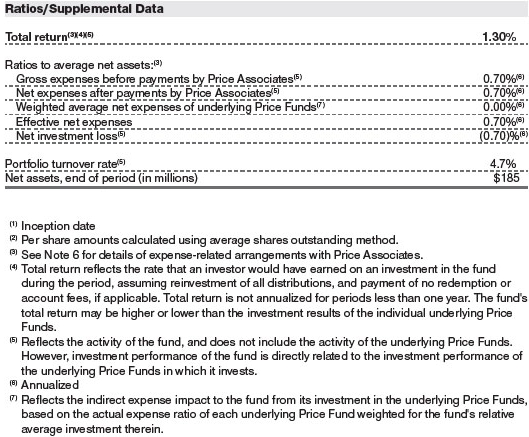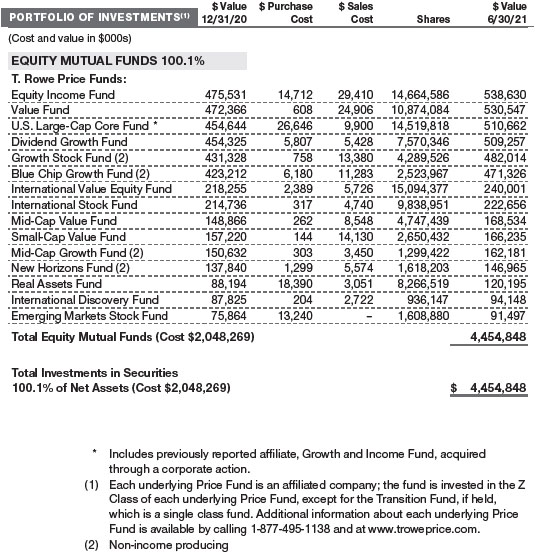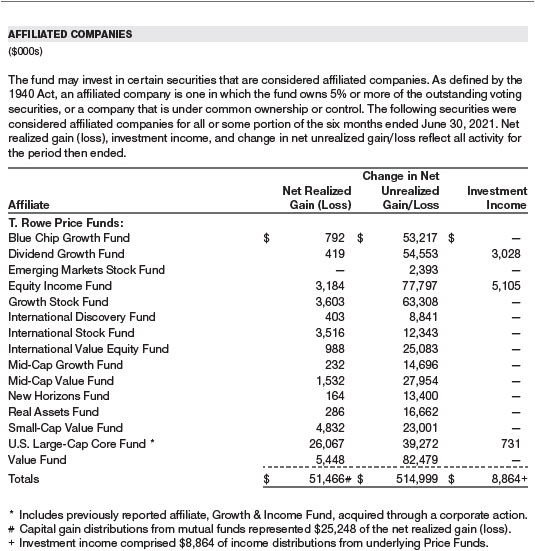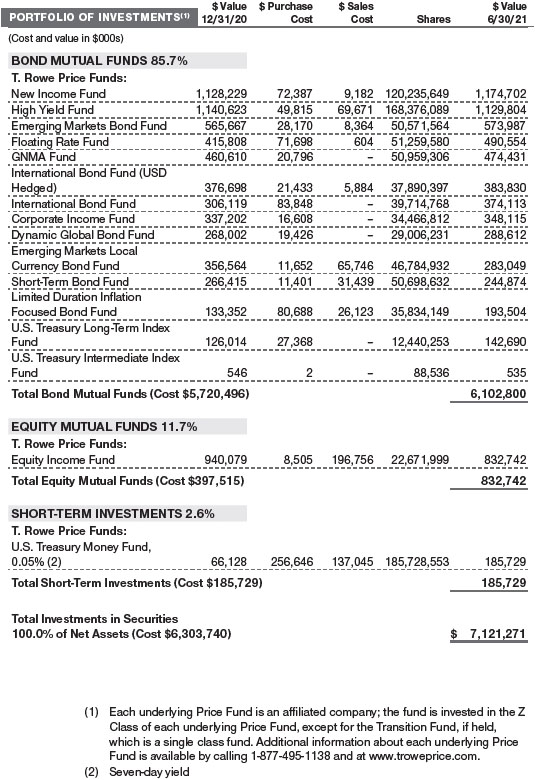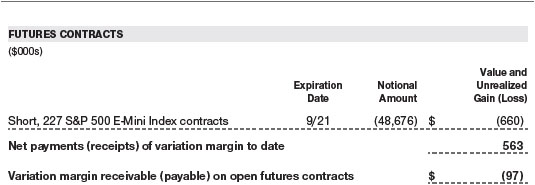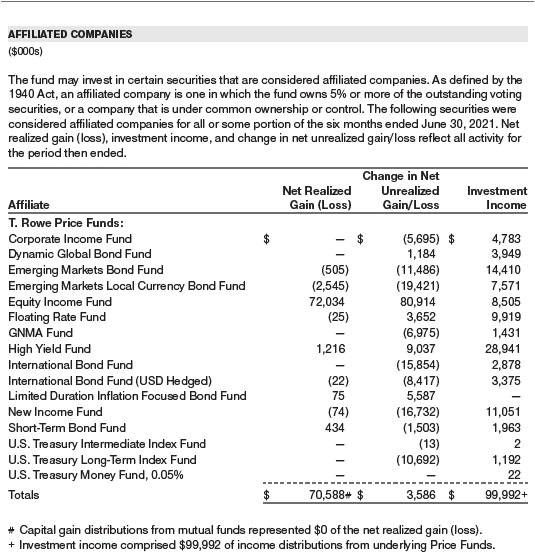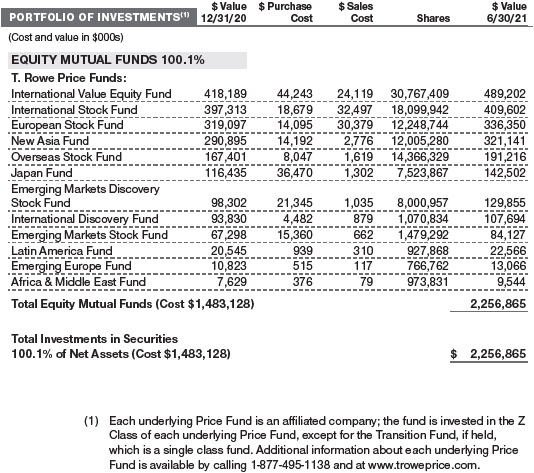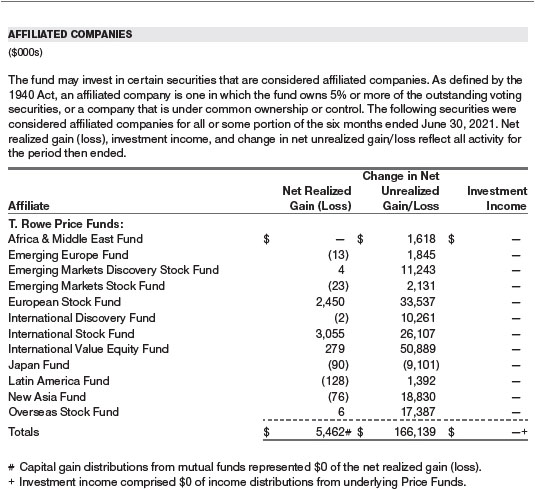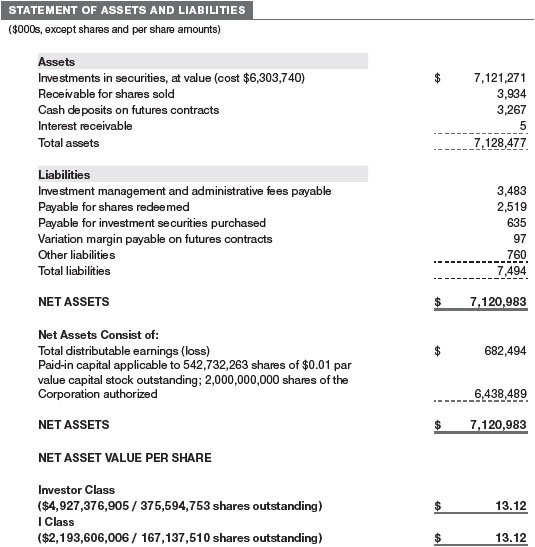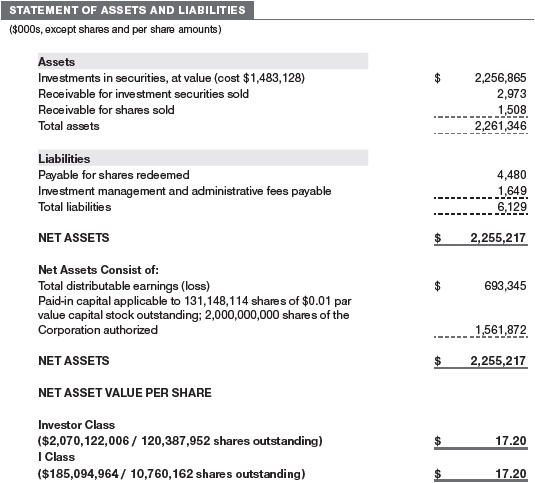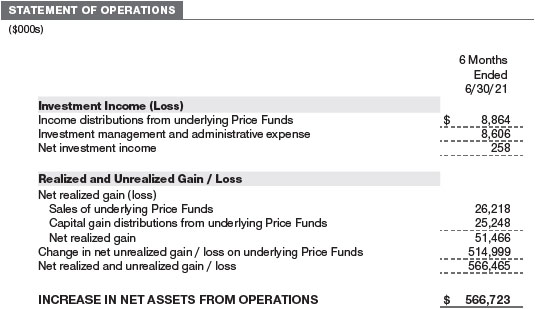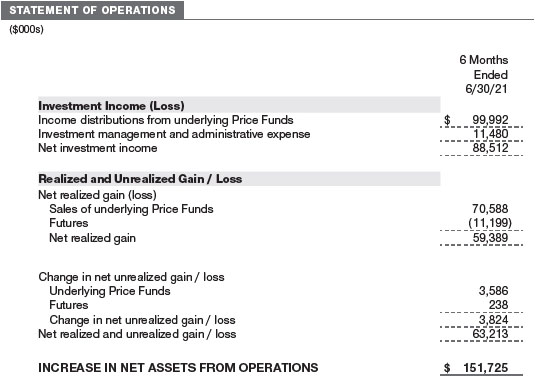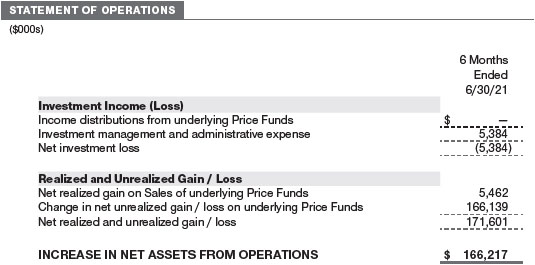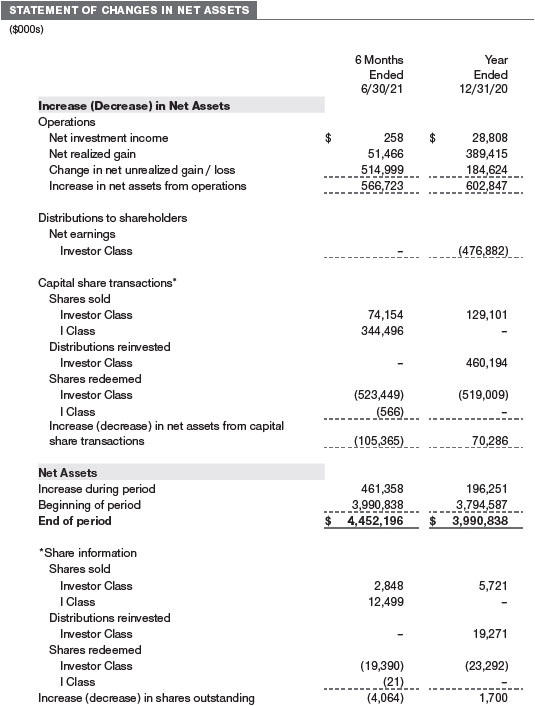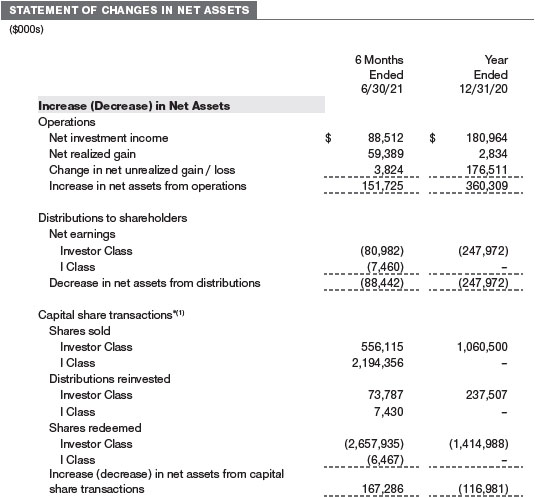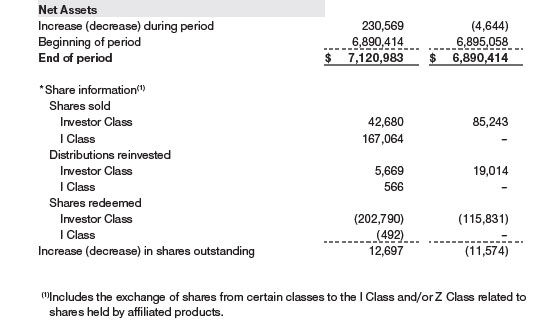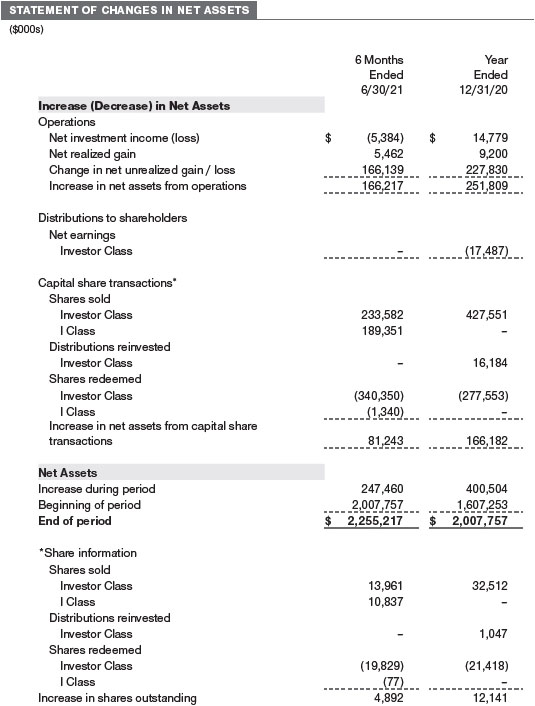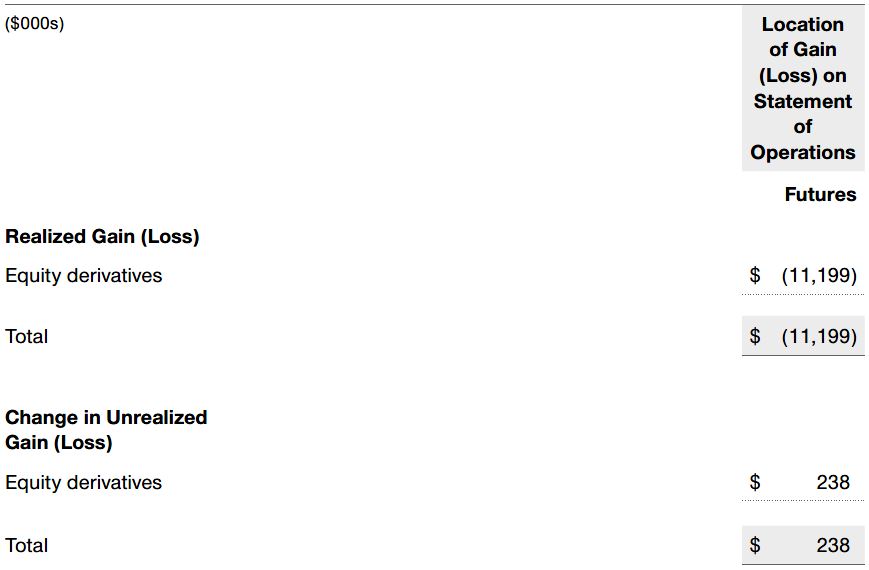UNITED STATES
SECURITIES AND EXCHANGE COMMISSION
Washington, D.C. 20549
FORM N-CSR
CERTIFIED SHAREHOLDER REPORT OF REGISTERED
MANAGEMENT INVESTMENT COMPANIES
Investment Company Act File Number: 811-04998
| T. Rowe Price Spectrum Fund, Inc. |
|
| (Exact name of registrant as specified in charter) |
| |
| 100 East Pratt Street, Baltimore, MD 21202 |
|
| (Address of principal executive offices) |
| |
| David Oestreicher |
| 100 East Pratt Street, Baltimore, MD 21202 |
|
| (Name and address of agent for service) |
Registrant’s telephone number, including area code: (410) 345-2000
Date of fiscal year end: December 31
Date of reporting period: June 30, 2021
Item 1. Reports to Shareholders
(a) Report pursuant to Rule 30e-1.
| Spectrum Funds | June 30, 2021 |
| PRSGX | Investor Class |
| TSVPX | I Class |
| RPSIX | Investor Class |
| TSPNX | I Class |
| PSILX | Investor Class |
| TSINX | I Class |
| T. ROWE PRICE SPECTRUM FUNDS |
|
HIGHLIGHTS
| ■ | During the six-month period ended June 30, 2021, the Spectrum Income Fund outperformed its benchmark, while the Spectrum International Equity Fund (formerly known as Spectrum International Fund) lagged its benchmark. The Spectrum Diversified Equity Fund (formerly known as Spectrum Growth Fund) outperformed its combined index portfolio but trailed the Russell 3000 Index. All the funds outpaced their Lipper peer benchmarks. |
| |
| ■ | Strong earnings reports, unprecedented fiscal stimulus and indications of significant pent-up demand have bolstered expectations for an acceleration in economic activity. However, there are headwinds to the recovery, including the potential for higher corporate tax rates in the U.S., continued supply chain disruptions, and central bank missteps. |
| |
| ■ | Exposure to diversifying sectors drove relative outperformance in the Spectrum Diversified Equity Fund and Spectrum Income Fund. In the Spectrum International Equity Fund, however, security selection in Japan and emerging markets weighed on relative results. |
| |
| ■ | Given the uncertain impact of positive and negative forces driving global financial markets, we believe that the Spectrum Funds’ broad diversification and the strength of T. Rowe Price’s fundamental research platform should benefit our investors over time across a range of market and economic environments. |
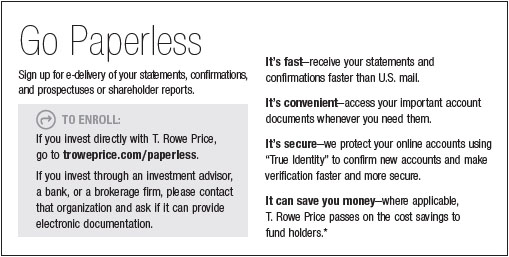
Log in to your account at troweprice.com for more information.
*Certain mutual fund accounts that are assessed an annual account service fee can also save money by switching to e-delivery.
CIO Market Commentary
Dear Shareholder
Global stock markets produced strong returns during the first half of 2021, while rising yields weighed on returns in some bond sectors. Investor sentiment was buoyed by the reopening of developed market economies, unprecedented fiscal and monetary stimulus, and expectations that the economy would benefit from a release of pent-up demand.
All major global and regional equity benchmarks recorded positive results during the period. Developed market stocks generally outperformed emerging markets, while in the U.S., small-cap equities outpaced large-caps and value performed better than growth. The large-cap S&P 500 Index returned 15% and finished the period at a record high. The energy sector, which was the worst performer in 2020, was the leader for the six-month period amid a sharp increase in oil prices. Financial stocks also produced strong results as banks benefited from an increase in long-term interest rates, while the real estate sector was helped by a rollback in many pandemic-related restrictions. Utilities underperformed with slight gains.
Fiscal and monetary support remained a key factor in providing a positive backdrop for markets. President Joe Biden signed the $1.9 trillion American Rescue Plan Act into law in March, and the Federal Reserve kept its short-term lending rates near zero. However, as a result of strong economic growth, central bank policymakers revised their outlook in a somewhat less dovish direction near the end of the period and indicated that rate hikes could commence in 2023, which was earlier than previously expected.
The economic recovery was evident in a variety of indicators. According to the latest estimate, U.S. gross domestic product grew at an annualized rate of 6.4% in the first quarter of 2021 following 4.3% growth in the fourth quarter of 2020. Weekly jobless claims declined throughout the period to new pandemic-era lows, although the monthly nonfarm payroll report disappointed at times as employers struggled to fill positions. Meanwhile, overall profits for companies in the S&P 500 rose by nearly 53% year over year in the first quarter, according to FactSet—the best showing since late 2009.
However, less favorably, inflation concerns led to some volatility in the equity market and caused a sharp rise in longer-term Treasury yields in the first quarter. (Bond prices and yields move in opposite directions.) While inflation measures were above the Fed’s 2% long-term inflation target toward the end of our reporting period—core consumer prices, for example, recorded their largest annual increase (3.8%) since 1992 in May—investors seemed to accept the Fed’s determination that rising price pressures were due to transitory factors arising from the reopening of the global economy.
Longer-term Treasury yields trended lower as inflation expectations began to wane later in the period, but they still finished significantly higher than they were at the end of 2020. Rising yields were a headwind for many fixed income investors; however, high yield bonds, which are less sensitive to interest rate changes, produced solid results, and investment-grade corporate bonds also performed well amid solid corporate fundamentals.
As we look ahead, the central question for investors—assuming the economy’s recovery from the pandemic continues apace—is whether the returns on financial assets will be as robust. Valuations are elevated in nearly all asset classes, and, in some areas, there are clear signs of speculation. That said, a transformed global economic landscape is generating potential opportunities as well as risks. Post-pandemic trends have the potential to create both winners and losers, giving active portfolio managers greater scope to seek excess returns. It is not an easy environment to invest in, but our investment teams remain rooted in company fundamentals and focused on the long term, and they will continue to apply strong fundamental analysis as they seek out the best investments for your portfolio.
Thank you for your continued confidence in T. Rowe Price.
Sincerely,
Robert Sharps
Group Chief Investment Officer
Management’s Discussion of Fund Performance
SPECTRUM DIVERSIFIED EQUITY FUND
INVESTMENT OBJECTIVE
The fund seeks long-term capital appreciation and growth of income with current income a secondary objective.
FUND COMMENTARY
How did the fund perform in the past six months?
The Spectrum Diversified Equity Fund returned 14.35% for the six-month period ended June 30, 2021. The fund outperformed its combined index portfolio, a custom weighted benchmark composed of indexes that represent the asset classes in which the fund invests, as well as the Lipper Multi-Cap Core Funds Index of peer funds but trailed the Russell 3000 Index. (Past performance cannot guarantee future results.)
What factors influenced the fund’s performance?
The Spectrum Diversified Equity Fund posted double-digit gains for the first half of the year. Exposure to diversifying sectors and security selection within the underlying strategies contributed to relative results, while tactical decisions were a modest detractor.
Within the fund, the inclusion of real assets equities, which outperformed global equities, contributed to relative performance. Real assets stocks were boosted by a surge in commodity prices, led by the names levered to the energy sector. The positive impact was, however, partly offset by an underweight allocation to the sector. Over the period, we trimmed our underweight as we expect commodity prices to continue benefiting in the near term from increased industrial and consumer demand as more economies fully reopen.
Overall, security selection in the underlying strategies added value. Notably, the U.S. large-cap value strategies outpaced their respective benchmarks and meaningfully contributed to relative returns. Overall, these strategies were lifted by strong gains in the communication services sector. Among U.S. large-cap growth stocks, performance was mixed. Security selection in the Growth Stock Fund boosted performance, while the Dividend Growth Fund’s higher-quality, lower-beta approach was a source of weakness in a high-momentum market environment. The international developed market large-cap strategies outpaced their respective benchmarks and added value. However, underperformance among U.S. small-cap value stocks was a drag. Despite strong absolute returns, our strategy lagged in an environment where the benchmark benefited from rallies in low-quality and momentum stocks. Our allocation, however, regained some lost ground in the second half of the reporting period.
How is the fund positioned?
The Spectrum Diversified Equity Fund invests in several underlying T. Rowe Price funds that focus on U.S. and international equities across the full range of market capitalizations and styles, as well as in emerging markets.
We are modestly overweight to international stocks relative to U.S. stocks. International equities offer relatively attractive valuations, and their more cyclical profile could be beneficial amid strong global growth. Improving vaccination rates, aggressive stimulus measures, and pent-up demand could also provide tailwinds for international stocks. Outside the U.S., we are overweight to emerging markets stocks relative to developed market stocks. Although fading Chinese stimulus, potential Fed tapering, and vaccine distribution challenges remain concerns, exposure to global trade and elevated commodity prices should boost emerging markets stocks.
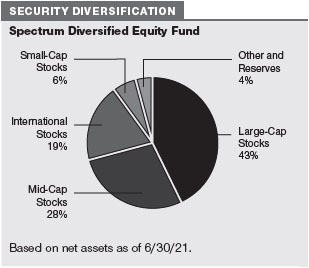
We increased our overweight in value-oriented equities. In our view, their cyclical orientation could benefit from the strong economic growth, infrastructure spending, and the surge in demand as life normalizes post-pandemic. As the recovery progresses, we believe upward pressure on interest rates—which are typically a headwind for growth stocks—could support value stocks, given their heavy exposure to financials. While we favor secular growth companies over the long term, they remain vulnerable to extended valuations and narrow leadership. We trimmed our overweight to U.S. small-cap stocks relative to larger companies. Small companies should be supported by economic growth and a strong earnings outlook, but they may be susceptible to a pullback given rising input costs.
Among international equities, we remain overweight to value stocks relative to growth stocks. The deep cyclical orientation of value stocks outside the U.S., their attractive relative valuations, and an improving earnings outlook could be catalysts for further rotation out of growth. Progress in vaccination rates may also provide a boost. Conversely, growth stocks outside the U.S. have a more defensive profile, with greater weights in the consumer staples and health care sectors, which are less compelling in a normalized economic environment.
We modestly pared our underweight to inflation-sensitive real assets equities. Supply bottlenecks and elevated demand continue to buoy commodity prices. However, their long-term outlook remains challenged by a supply/demand imbalance and a less accommodative Fed. Despite rising interest rates, the outlook for real estate benefits from an environment of improving growth and constrained supply, as well as reasonable valuations.
SPECTRUM INCOME FUND
INVESTMENT OBJECTIVE
The fund seeks a high level of current income with moderate share price fluctuation.
FUND COMMENTARY
How did the fund perform in the past six months?
The Spectrum Income Fund returned 2.19% for the six-month period ended June 30, 2021. The fund outperformed both the Bloomberg Barclays U.S. Aggregate Bond Index benchmark and its peer Lipper Multi-Sector Income Funds Average. (Past performance cannot guarantee future results.)
What factors influenced the fund’s performance?
The Spectrum Income Fund significantly outperformed its benchmark for the six-month period. Exposure to sectors and asset classes that are not included in the fund’s benchmark drove outperformance. Most notably, dividend-paying equities posted double-digit gains and strongly outpaced investment-grade bonds. Exposure to the asset class and positive security selection within the strategy meaningfully contributed to relative performance for the period.
Overall, fixed income diversifiers added value. High yield bonds and floating rate bank loans—which were supported by favorable corporate earnings and their lower sensitivity to rising interest rates—outperformed investment-grade bonds. Conversely, the inclusion of long-term U.S. Treasuries was a drag, as they were among the worst performers in fixed income; however, a tactical underweight allocation mostly offset the negative impact. Exposure to unhedged nondollar bonds also weighed on relative returns.
Security selection helped relative results. The dividend-paying equity strategy outperformed its style-specific benchmark and contributed to relative performance. Within fixed income, the investment-grade bond and emerging markets bond strategies also outpaced their respective benchmarks and boosted returns.
How is the fund positioned?
The Spectrum Income Fund invests primarily in fixed income securities through a diversified mix of U.S. and international T. Rowe Price mutual funds. Underlying investments also include a fund focused on dividend-paying U.S. large-cap stocks.
Concerns around peaking growth and higher inflation expectations could keep investment-grade bond yields elevated; however, the impact could be capped as fiscal policies becomes less accommodative. Investment-grade corporate valuations appear less compelling as spreads near record lows.
We remain overweight to high yield bonds. Although their upside is limited, given elevated valuations, their yields are still relatively attractive compared with investment-grade debt. We are cautious of risks from credit downgrades and defaults, but credit fundamentals appear broadly supportive amid a rebound in commodities. We are overweight to floating rate bank loans, which offer favorable relative valuations and solid credit fundamentals. In our view, the sector should benefit from its shorter duration profile and also offers optionality, as coupons reset higher as interest rates rise. Floating rate loans also have less exposure to the energy sector and higher standing in the capital structure.
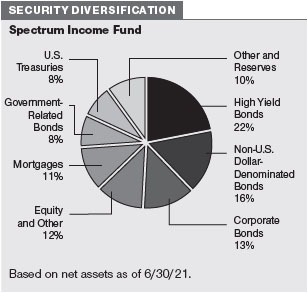
We are overweight to hedged nondollar bonds. On a U.S. dollar-hedged basis, the hedged-yield advantage has moderated as short-term interest rate differentials have narrowed. Yields are anchored by major central banks’ policies, which should likely remain unchanged through 2022, although a rise in inflation could bias long-term yields. We are underweight to unhedged nondollar bonds. Extended duration is a risk for nondollar bonds, from the perspective of unhedged U.S. investors, and low/negative yields remain uncompelling versus U.S. yields.
We are neutral emerging markets U.S. dollar-denominated bonds. While the sector offers attractive yields compared with developed markets and improving growth is broadly supportive, vulnerabilities vary across countries in resurging coronavirus outbreaks, rising inflation, and susceptibility to rising interest rates. We are overweight to emerging markets local currency bonds. Valuations remain modestly attractive, and the improving macroeconomic environment and a potentially weaker dollar could be supportive; however, higher U.S. interest rates and local central bank rate hikes could be a headwind.
We remain underweight to long-term U.S. Treasury bonds. Longer-duration bonds remain vulnerable to a further rise in yields as growth and inflation expectations remain elevated, but expectations for tighter policy could contribute to rate volatility. However, given current low yields, the long end is the only portion of the yield curve with room to rally in a potential risk-off environment. While we do not see significant negative shocks as likely, a modest allocation to long-term Treasuries offers ballast should significant volatility return to equity markets.
We tilted to an underweight to dividend-paying equities. Although strong economic and earnings growth could support equities, their valuations appear extended, and their risk/reward profile appears less compelling after a dramatic rebound from the drastic sell-off in early 2020. Despite higher yields, bonds remain vulnerable to peaking growth and elevated inflation expectations.
SPECTRUM INTERNATIONAL EQUITY FUND
INVESTMENT OBJECTIVE
The fund seeks long-term capital appreciation.
FUND COMMENTARY
How did the fund perform in the past six months?
The Spectrum International Equity Fund returned 8.18% for the six-month period ended June 30, 2021. The fund outperformed the Lipper International Multi-Cap Growth Funds Average but lagged its benchmark, the MSCI All Country World Index ex USA Net. (Past performance cannot guarantee future results.)
What factors influenced the fund’s performance?
During the reporting period, the Spectrum International Equity Fund lagged its benchmark.
Differences in the regional profile of the portfolio versus the benchmark weighed on performance—particularly, an underweight to outperforming Canadian equities.
Within the underlying strategies, the Japan Fund was a notable detractor for the period. The cyclical, low-quality rally proved to be a headwind, given the fund’s bias toward quality, secular growth companies—which, while unfavorable during the last six months, helped deliver stellar results over the course of 2020. Within the fund, holdings in the consumer discretionary, information technology, and industrials and business services sectors weighed on relative performance. The Emerging Markets Stock Fund also trailed its benchmark for the period, hurt by a meaningful underweight allocation and stock selection in the materials sector.
Conversely, strong security selection in the International Value Equity Fund contributed to relative performance. Sector performance was mostly positive across the various regions. Stock selection and a favorable overweight allocation to the information technology sector, especially names within semiconductors and semiconductor equipment, was the top contributor to results. Holdings in the financials and health care sectors also added value. On a regional basis, holdings in Japan and developed Pacific Asia were among the best performers. The International Stock Fund, led by names in the consumer discretionary and information technology sectors, and the Overseas Stock Fund, led by names in the health care and utilities sectors, also outperformed their respective benchmarks and boosted results.
How is the fund positioned?
The Spectrum International Equity Fund offers investors broadly diversified exposure to international equities in developed and emerging markets.
We are overweight to emerging markets stocks relative to developed market stocks. Although fading Chinese stimulus, potential Fed tapering, and vaccine distribution challenges remain concerns, exposure to global trade and elevated commodity prices should boost emerging markets stocks.
Among developed markets, we are overweight to Japanese equities. Fiscal and monetary stimulus continue to provide a solid backdrop for the nation’s economic recovery, and new Prime Minister Yoshihide Suga is likely to continue the pro-business policies of his predecessor, Shinzo Abe. Despite year-to-date weakness and challenges in vaccine rollout, the cyclical recovery in global markets should provide a sustained catalyst for Japanese stocks.
Economic activity in the broader Asia Pacific region may also be supportive, given the region’s resilience during the coronavirus pandemic and ongoing Chinese stimulus measures.
We are underweight to European equities. Economies in the region continue to be heavily impacted by the coronavirus pandemic, and the embattled rollout of vaccine distribution could delay a return to normal economic activity. The region has been supported by accommodative actions from both the European Central Bank and the European Union, and, while we believe more cyclically oriented European equities are well positioned to benefit from a global recovery as the effects of the pandemic wane, longer-term catalysts for the broader region are scarce.
We remain overweight to value stocks relative to growth stocks. The deep cyclical orientation of value stocks outside the U.S., their attractive relative valuations, and an improving earnings outlook could be catalysts for further rotation out of growth. Progress in vaccination rates may also provide a boost. Conversely, growth stocks outside the U.S. have a more defensive profile, with greater weights in the consumer staples and health care sectors, which are less compelling in a normalized economic environment.
What is portfolio management’s outlook?
Global markets have staged a remarkable recovery from the historic coronavirus-induced sell-off last year. While the virus remains a key risk to public health and economic activity, significant progress in the distribution of vaccines and the loosening of government restrictions has contributed to improved sentiment. Moreover, central banks and governments have taken aggressive monetary and fiscal stimulus measures, which have offset economic damage and provided a potent tailwind for risk assets. For the most part, markets appear to have priced in the likelihood that economic activity will continue to normalize over the coming months. However, in our view, there are several risks on the horizon that have yet to be fully appreciated.
Strong earnings reports, unprecedented fiscal stimulus, and indications of significant pent-up demand have bolstered expectations for an acceleration in economic activity in the year ahead but have also given rise to inflation fears. In the U.S., proposals for further stimulus and infrastructure spending are likely to be married to an increase in corporate tax rates. China faces pressures from supply chain disruptions, rising commodities costs, moderating growth, and fading stimulus, while in certain other regions virus mutations and significant struggles with vaccine distribution pose challenges. While the global economy has been buoyed by a period of extreme liquidity driven by fiscal and monetary stimulus, these tailwinds are likely to fade as central banks begin to pursue more moderate policies. Although these conditions may not materialize as significant headwinds for growth, we believe they contribute to a less compelling risk/reward profile going forward, and we have positioned our portfolios accordingly.
The elevated levels of volatility and uncertainty in global markets underscore the value of our thoughtful strategic investing approach. Given the uncertain impact of positive and negative forces driving global financial markets, we believe that the Spectrum Funds’ broad diversification and the strength of T. Rowe Price’s fundamental research platform should benefit our investors over time across a range of market and economic environments.
The views expressed reflect the opinions of T. Rowe Price as of the date of this report and are subject to change based on changes in market, economic, or other conditions. These views are not intended to be a forecast of future events and are no guarantee of future results.
RISKS OF INVESTING
As with all stock and bond mutual funds, each fund’s share price can fall because of weakness in the stock or bond markets, a particular industry, or specific holdings. Stock markets can decline for many reasons, including adverse political or economic developments, changes in investor psychology, or heavy institutional selling. The prospects for an industry or company may deteriorate because of a variety of factors, including disappointing earnings or changes in the competitive environment. In addition, the investment manager’s assessment of companies held in a fund may prove incorrect, resulting in losses or poor performance even in rising markets.
Bonds are subject to interest rate risk, the decline in bond prices that usually accompanies a rise in interest rates, and credit risk, the chance that any fund holding could have its credit rating downgraded or that a bond issuer will default (fail to make timely payments of interest or principal), potentially reducing the fund’s income level and share price. High yield corporate bonds could have greater price declines than funds that invest primarily in high-quality bonds. Companies issuing high yield bonds are not as strong financially as those with higher credit ratings, so the bonds are usually considered speculative investments.
Funds that invest overseas may carry more risk than funds that invest strictly in U.S. assets. Risks can result from varying stages of economic and political development; differing regulatory environments, trading days, and accounting standards; and higher transaction costs of non-U.S. markets. Non-U.S. investments are also subject to currency risk, or a decline in the value of a foreign currency versus the U.S. dollar, which reduces the dollar value of securities denominated in that currency.
BENCHMARK INFORMATION
Combined index portfolio: An unmanaged blended index portfolio created as a custom benchmark for the Spectrum Diversified Equity Fund consisting of 70% Russell 3000 Index and 30% MSCI All Country World ex-USA IMI.
Note: Bloomberg Index Services Limited. BLOOMBERG® is a trademark and service mark of Bloomberg Finance L.P. and its affiliates (collectively “Bloomberg”). BARCLAYS® is a trademark and service mark of Barclays Bank Plc (collectively with its affiliates, “Barclays”), used under license. Bloomberg or Bloomberg’s licensors, including Barclays, own all proprietary rights in the Bloomberg Barclays Indices. Neither Bloomberg nor Barclays approves or endorses this material, or guarantees the accuracy or completeness of any information herein, or makes any warranty, express or implied, as to the results to be obtained therefrom and, to the maximum extent allowed by law, neither shall have any liability or responsibility for injury or damages arising in connection therewith.
Note: Lipper, a Thomson Reuters Company, is the source for all Lipper content reflected in these materials. Copyright 2021 © Refinitiv. All rights reserved. Any copying, republication or redistribution of Lipper content is expressly prohibited without the prior written consent of Lipper. Lipper shall not be liable for any errors or delays in the content, or for any actions taken in reliance thereon.
Note: MSCI makes no express or implied warranties or representations and shall have no liability whatsoever with respect to any MSCI data contained herein. The MSCI data may not be further redistributed or used as a basis for other indices or any securities or financial products. This report is not approved, reviewed, or produced by MSCI.
Note: Frank Russell Company (Russell) is the source and owner of the Russell index data contained or reflected in these materials and all trademarks and copyrights related thereto. Russell® is a registered trademark of Russell. Russell is not responsible for the formatting or configuration of these materials or for any inaccuracy in T. Rowe Price Associates’ presentation thereof.
GROWTH OF $10,000
This chart shows the value of a hypothetical $10,000 investment in the fund over the past 10 fiscal year periods or since inception (for funds lacking 10-year records). The result is compared with benchmarks, which include a broad-based market index and may also include a peer group average or index. Market indexes do not include expenses, which are deducted from fund returns as well as mutual fund averages and indexes.
AVERAGE ANNUAL COMPOUND TOTAL RETURN
GROWTH OF $10,000
This chart shows the value of a hypothetical $10,000 investment in the fund over the past 10 fiscal year periods or since inception (for funds lacking 10-year records). The result is compared with benchmarks, which include a broad-based market index and may also include a peer group average or index. Market indexes do not include expenses, which are deducted from fund returns as well as mutual fund averages and indexes.
AVERAGE ANNUAL COMPOUND TOTAL RETURN
GROWTH OF $10,000
This chart shows the value of a hypothetical $10,000 investment in the fund over the past 10 fiscal year periods or since inception (for funds lacking 10-year records). The result is compared with benchmarks, which include a broad-based market index and may also include a peer group average or index. Market indexes do not include expenses, which are deducted from fund returns as well as mutual fund averages and indexes.
AVERAGE ANNUAL COMPOUND TOTAL RETURN
EXPENSE RATIO
FUND EXPENSE EXAMPLE
As a mutual fund shareholder, you may incur two types of costs: (1) transaction costs, such as redemption fees or sales loads, and (2) ongoing costs, including management fees, distribution and service (12b-1) fees, and other fund expenses. The following example is intended to help you understand your ongoing costs (in dollars) of investing in the fund and to compare these costs with the ongoing costs of investing in other mutual funds. The example is based on an investment of $1,000 invested at the beginning of the most recent six-month period and held for the entire period.
Please note that the fund has two share classes: The original share class (Investor Class) charges no distribution and service (12b-1) fee, and the I Class shares are also available to institutionally oriented clients and impose no 12b-1 or administrative fee payment. Each share class is presented separately in the table.
Actual Expenses
The first line of the following table (Actual) provides information about actual account values and expenses based on the fund’s actual returns. You may use the information on this line, together with your account balance, to estimate the expenses that you paid over the period. Simply divide your account value by $1,000 (for example, an $8,600 account value divided by $1,000 = 8.6), then multiply the result by the number on the first line under the heading “Expenses Paid During Period” to estimate the expenses you paid on your account during this period.
Hypothetical Example for Comparison Purposes
The information on the second line of the table (Hypothetical) is based on hypothetical account values and expenses derived from the fund’s actual expense ratio and an assumed 5% per year rate of return before expenses (not the fund’s actual return). You may compare the ongoing costs of investing in the fund with other funds by contrasting this 5% hypothetical example and the 5% hypothetical examples that appear in the shareholder reports of the other funds. The hypothetical account values and expenses may not be used to estimate the actual ending account balance or expenses you paid for the period.
Note: T. Rowe Price charges an annual account service fee of $20, generally for accounts with less than $10,000. The fee is waived for any investor whose T. Rowe Price mutual fund accounts total $50,000 or more; accounts electing to receive electronic delivery of account statements, transaction confirmations, prospectuses, and shareholder reports; or accounts of an investor who is a T. Rowe Price Personal Services or Enhanced Personal Services client (enrollment in these programs generally requires T. Rowe Price assets of at least $250,000). This fee is not included in the accompanying table. If you are subject to the fee, keep it in mind when you are estimating the ongoing expenses of investing in the fund and when comparing the expenses of this fund with other funds.
You should also be aware that the expenses shown in the table highlight only your ongoing costs and do not reflect any transaction costs, such as redemption fees or sales loads. Therefore, the second line of the table is useful in comparing ongoing costs only and will not help you determine the relative total costs of owning different funds. To the extent a fund charges transaction costs, however, the total cost of owning that fund is higher.
| T. ROWE PRICE SPECTRUM DIVERSIFIED EQUITY FUND |
|
Unaudited
The accompanying notes are an integral part of these financial statements.
Unaudited
The accompanying notes are an integral part of these financial statements.
| T. ROWE PRICE SPECTRUM INCOME FUND |
|
Unaudited
The accompanying notes are an integral part of these financial statements.
Unaudited
The accompanying notes are an integral part of these financial statements.
| T. ROWE PRICE SPECTRUM INTERNATIONAL EQUITY FUND |
|
Unaudited
The accompanying notes are an integral part of these financial statements.
Unaudited
The accompanying notes are an integral part of these financial statements.
| T. ROWE PRICE SPECTRUM DIVERSIFIED EQUITY FUND |
|
June 30, 2021 (Unaudited)
The accompanying notes are an integral part of these financial statements.
| T. ROWE PRICE SPECTRUM INCOME FUND |
|
June 30, 2021 (Unaudited)
The accompanying notes are an integral part of these financial statements.
| T. ROWE PRICE SPECTRUM INTERNATIONAL EQUITY FUND |
|
June 30, 2021 (Unaudited)
The accompanying notes are an integral part of these financial statements.
| T. ROWE PRICE SPECTRUM DIVERSIFIED EQUITY FUND |
|
June 30, 2021 (Unaudited)
The accompanying notes are an integral part of these financial statements.
| T. ROWE PRICE SPECTRUM INCOME FUND |
|
June 30, 2021 (Unaudited)
The accompanying notes are an integral part of these financial statements.
| T. ROWE PRICE SPECTRUM INTERNATIONAL EQUITY FUND |
|
June 30, 2021 (Unaudited)
The accompanying notes are an integral part of these financial statements.
| T. ROWE PRICE SPECTRUM DIVERSIFIED EQUITY FUND |
|
Unaudited
The accompanying notes are an integral part of these financial statements.
| T. ROWE PRICE SPECTRUM INCOME FUND |
|
Unaudited
The accompanying notes are an integral part of these financial statements.
| T. ROWE PRICE SPECTRUM INTERNATIONAL EQUITY FUND |
|
Unaudited
The accompanying notes are an integral part of these financial statements.
| T. ROWE PRICE SPECTRUM DIVERSIFIED EQUITY FUND |
|
Unaudited
The accompanying notes are an integral part of these financial statements.
| T. ROWE PRICE SPECTRUM INCOME FUND |
|
Unaudited
The accompanying notes are an integral part of these financial statements.
| T. ROWE PRICE SPECTRUM INTERNATIONAL EQUITY FUND |
|
Unaudited
The accompanying notes are an integral part of these financial statements.
| T. ROWE PRICE SPECTRUM FUNDS |
|
Unaudited
| NOTES TO FINANCIAL STATEMENTS |
T. Rowe Price Spectrum Fund, Inc. (the corporation) is registered under the Investment Company Act of 1940 (the 1940 Act). Spectrum Diversified Equity Fund, formerly the Spectrum Growth Fund, Spectrum Income Fund, and Spectrum International Equity Fund, formerly the Spectrum International Fund (collectively, the Spectrum Funds) are diversified open-end management investment companies established by the corporation.
Each Spectrum Fund broadly diversifies its assets within specified ranges among a set of T. Rowe Price mutual funds (underlying Price Funds) representing specific market segments. Spectrum Diversified Equity seeks long-term capital appreciation and growth of income with current income as a secondary objective. Spectrum Income seeks a high level of current income with moderate share price fluctuation. Spectrum International Equity seeks long-term capital appreciation.
Each fund has two classes of shares as follows: Spectrum Diversified Equity Fund (Investor Class) and Spectrum Diversified Equity Fund – I Class (I Class); Spectrum Income Fund (Investor Class) and Spectrum Income Fund – I Class (I Class); and Spectrum International Equity Fund (Investor Class) and Spectrum International Equity Fund – I Class (I Class). I Class shares require a $1 million initial investment minimum, although the minimum generally is waived for retirement plans, financial intermediaries, and certain other accounts. Each class has exclusive voting rights on matters related solely to that class; separate voting rights on matters that relate to both classes; and, in all other respects, the same rights and obligations as the other class.
NOTE 1 - SIGNIFICANT ACCOUNTING POLICIES
Basis of Preparation Each fund is an investment company and follows accounting and reporting guidance in the Financial Accounting Standards Board Accounting Standards Codification Topic 946 (ASC 946). The accompanying financial statements were prepared in accordance with accounting principles generally accepted in the United States of America (GAAP), including, but not limited to, ASC 946. GAAP requires the use of estimates made by management. Management believes that estimates and valuations of the underlying Price Funds are appropriate; however, actual results may differ from those estimates, and the valuations reflected in the accompanying financial statements may differ from the value ultimately realized upon sale of the underlying Price Funds.
Investment Transactions, Investment Income, and Distributions Investment transactions are accounted for on the trade date basis. Income and expenses are recorded on the accrual basis. Realized gains and losses are reported on the identified cost basis. Income tax-related interest and penalties, if incurred, are recorded as income tax expense. Dividends received from underlying Price Fund investments are reflected as dividend income; capital gain distributions are reflected as realized gain/loss. Income and capital gain distributions from the underlying Price Funds are recorded on the ex-dividend date. Distributions to shareholders are recorded on the ex-dividend date. Income distributions are declared by Spectrum Income daily and paid monthly. Income distributions, if any, are declared and paid by Spectrum Diversified Equity and Spectrum International Equity annually. A capital gain distribution may also be declared and paid by each fund annually.
Class Accounting Investment management and administrative expenses incurred by each class are charged directly to the class to which they relate. Expenses common to all classes, income distributions from the underlying Price Funds and realized and unrealized gains and losses are allocated to the classes based upon the relative daily net assets of each class.
Capital Transactions Each investor’s interest in the net assets of each fund is represented by fund shares. Each fund’s net asset value (NAV) per share is computed at the close of the New York Stock Exchange (NYSE), normally 4 p.m. ET, each day the NYSE is open for business. However, the NAV per share may be calculated at a time other than the normal close of the NYSE if trading on the NYSE is restricted, if the NYSE closes earlier, or as may be permitted by the SEC. Purchases and redemptions of fund shares are transacted at the next-computed NAV per share, after receipt of the transaction order by T. Rowe Price Associates, Inc., or its agents.
Indemnification In the normal course of business, the funds may provide indemnification in connection with its officers and directors, service providers, and/or private company investments. Each fund’s maximum exposure under these arrangements is unknown; however, the risk of material loss is currently considered to be remote.
NOTE 2 - VALUATION
Each fund’s financial instruments are valued at the close of the NYSE and are reported at fair value, which GAAP defines as the price that would be received to sell an asset or paid to transfer a liability in an orderly transaction between market participants at the measurement date. Investments in the underlying Price Funds are valued at their closing NAV per share on the day of valuation. Futures contracts, if any, are valued at closing settlement prices. Assets and liabilities other than financial instruments, including short-term receivables and payables, are carried at cost, or estimated realizable value, if less, which approximates fair value.
The T. Rowe Price Valuation Committee (the Valuation Committee) is an internal committee that has been delegated certain responsibilities by the funds' Board of Directors (the Board) to ensure that financial instruments are appropriately priced at fair value in accordance with GAAP and the 1940 Act. Subject to oversight by the Board, the Valuation Committee develops and oversees pricing-related policies and procedures and approves all fair value determinations. Specifically, the Valuation Committee establishes policies and procedures used in valuing financial instruments; determines pricing techniques, sources, and persons eligible to effect fair value pricing actions; evaluates the service and performance of the pricing vendors; oversees the pricing process to ensure policies and procedures are being followed; and provides guidance on internal controls and valuation-related matters. The Valuation Committee provides periodic reporting to the Board on valuation matters.
Various valuation techniques and inputs are used to determine the fair value of financial instruments. GAAP establishes the following fair value hierarchy that categorizes the inputs used to measure fair value:
Level 1 – quoted prices (unadjusted) in active markets for identical financial instruments that the fund can access at the reporting date
Level 2 – inputs other than Level 1 quoted prices that are observable, either directly or indirectly (including, but not limited to, quoted prices for similar financial instruments in active markets, quoted prices for identical or similar financial instruments in inactive markets, interest rates and yield curves, implied volatilities, and credit spreads)
Level 3 – unobservable inputs (including the fund's own assumptions in determining fair value)
Observable inputs are developed using market data, such as publicly available information about actual events or transactions, and reflect the assumptions that market participants would use to price the financial instrument. Unobservable inputs are those for which market data are not available and are developed using the best information available about the assumptions that market participants would use to price the financial instrument. GAAP requires valuation techniques to maximize the use of relevant observable inputs and minimize the use of unobservable inputs. When multiple inputs are used to derive fair value, the financial instrument is assigned to the level within the fair value hierarchy based on the lowest-level input that is significant to the fair value of the financial instrument. Input levels are not necessarily an indication of the risk or liquidity associated with financial instruments at that level but rather the degree of judgment used in determining those values. On June 30, 2021, all of the fund's financial instruments were classified as Level 1, based on the inputs used to determine their fair values.
NOTE 3 - DERIVATIVE INSTRUMENTS
The funds may use derivatives in an effort to manage cash flows efficiently, remain fully invested, or facilitate asset allocation and rebalancing. As defined by GAAP, a derivative is a financial instrument whose value is derived from an underlying security price, foreign exchange rate, interest rate, index of prices or rates, or other variable; it requires little or no initial investment and permits or requires net settlement. The funds invest in derivatives only if the expected risks and rewards are consistent with its investment objectives, policies, and overall risk profile, as described in its prospectus and Statement of Additional Information. The risks associated with the use of derivatives are different from, and potentially much greater than, the risks associated with investing directly in the instruments on which the derivatives are based. The funds at all times maintain sufficient cash reserves, liquid assets, or other SEC-permitted asset types to cover their settlement obligations under open derivative contracts.
The funds value their derivatives at fair value and recognizes changes in fair value currently in their results of operations. Accordingly, the funds do not follow hedge accounting, even for derivatives employed as economic hedges. Generally, the funds account for their derivatives on a gross basis. They do not offset the fair value of derivative liabilities against the fair value of derivative assets on their financial statements, nor do they offset the fair value of derivative instruments against the right to reclaim or obligation to return collateral. The following table summarizes the fair value of each fund’s futures contracts held, if any, as of June 30, 2021, and the related location on the accompanying Statement of Assets and Liabilities, presented by primary underlying risk exposure:
Spectrum Income Fund
As of June 30, 2021, the Spectrum Diversified Equity Fund and Spectrum International Equity Fund held no derivative instruments.
Additionally, the amount of gains and losses on futures recognized in fund earnings during the six months ended June 30, 2021, and the related location on the accompanying Statement of Operations is summarized in the following table by primary underlying risk exposure:
Spectrum Income Fund
During the six months ended June 30, 2021, the Spectrum Diversified Equity Fund and Spectrum International Equity Fund recognized no gains or losses on derivative instruments.
Counterparty Risk and Collateral The funds invest in exchange-traded futures. Counterparty risk on such derivatives is minimal because the clearinghouse provides protection against counterparty defaults. For futures, the funds are each required to deposit collateral in an amount specified by the clearinghouse and the clearing firm (margin requirement) and the margin requirement must be maintained over the life of the contract. Each clearinghouse and clearing firm, in its sole discretion, may adjust the margin requirements applicable to the fund.
Collateral may be in the form of cash or debt securities issued by the U.S. government or related agencies. Cash posted by the fund is reflected as cash deposits in the accompanying financial statements and generally is restricted from withdrawal by the fund; securities posted by the fund are so noted in the accompanying Portfolio of Investments; both remain in the fund’s assets. While typically not sold in the same manner as equity or fixed income securities, exchange-traded derivatives may be closed out only on the exchange or clearinghouse where the contracts were traded. This ability is subject to the liquidity of underlying positions. As of June 30, 2021, cash of $3,267,000 had been posted by Spectrum Income Fund for exchange-traded derivatives.
Futures Contracts A futures contract provides for the future sale by one party and purchase by another of a specified amount of a specific underlying financial instrument at an agreed upon price, date, time, and place. The funds currently invest only in exchange-traded futures, which generally are standardized as to maturity date, underlying financial instrument, and other contract terms. Payments are made or received by the fund each day to settle daily fluctuations in the value of the contract (variation margin), which reflect changes in the value of the underlying financial instrument. Variation margin is recorded as unrealized gain or loss until the contract is closed. The value of a futures contract included in net assets is the amount of unsettled variation margin; net variation margin receivable is reflected as an asset and net variation margin payable is reflected as a liability on the accompanying Statement of Assets and Liabilities. Risks related to the use of futures contracts include possible illiquidity of the futures markets, contract prices that can be highly volatile and imperfectly correlated to movements in hedged security values, and potential losses in excess of the fund’s initial investment. During the six months ended June 30, 2021, the volume of the activity in futures, based on underlying notional amounts, was generally less than 1% for the Spectrum Income Fund.
NOTE 4 - INVESTMENTS IN UNDERLYING PRICE FUNDS
Purchases and sales of the underlying Price Funds during the six months ended June 30, 2021, were as follows:
NOTE 5 - FEDERAL INCOME TAXES
No provision for federal income taxes is required since each fund intends to continue to qualify as a regulated investment company under Subchapter M of the Internal Revenue Code and distribute to shareholders all of its taxable income and gains. Distributions determined in accordance with federal income tax regulations may differ in amount or character from net investment income and realized gains for financial reporting purposes. Financial reporting records are adjusted for permanent book/tax differences to reflect tax character but are not adjusted for temporary differences. The amount and character of tax-basis distributions and composition of net assets are finalized at fiscal year-end; accordingly, tax-basis balances have not been determined as of the date of this report.
At June 30, 2021, the cost of investments for federal income tax purposes and net unrealized gain (loss) on investments was as follows:
NOTE 6 - RELATED PARTY TRANSACTIONS
The Spectrum Funds are managed by T. Rowe Price Associates, Inc. (Price Associates), a wholly owned subsidiary of T. Rowe Price Group, Inc. Price Associates, directly or through sub-advisory agreements with its wholly owned subsidiaries, also provides investment management services to all the underlying Price Funds. Pursuant to various service agreements, Price Associates and its wholly owned subsidiaries provide shareholder servicing and administrative services as well as certain accounting, marketing, and other services to the Spectrum Funds. Certain officers and directors of the Spectrum Funds are also officers and directors of Price Associates and its subsidiaries and of the underlying Price Funds.
Each fund operates in accordance with an amended investment management agreement (amended management agreement), between the corporation, on behalf of the funds, and Price Associates. Under the amended agreement, the Spectrum Diversified Equity Fund pays a fee rate of 0.73% for the Investor Class and 0.58% for the I Class; the Spectrum Income Fund pays a fee rate of 0.62% for the Investor Class and 0.47% for the I Class; and the Spectrum International Equity Fund pays a fee rate of 0.89% for the Investor Class and 0.74% for the I Class, respectively. The all-inclusive management fee covers investment management and all of each fund’s operating expenses except for interest expense; expenses related to borrowings, taxes, and brokerage; and any nonrecurring expenses.
Effective March 24, 2021, the date that each fund began charging, an all-inclusive management fee, the funds also converted from each underlying Price Fund’s Investor Class to its Z Class. Price Associates is contractually obligated to waive and/ or bear all of the Z Class’ expenses, other than interest; expenses related to borrowings, taxes, and brokerage; and nonrecurring expenses. Prior to March 24, 2021, the funds paid no management fees; however, Price Associates received management fees from the underlying Price Funds. The funds operated in accordance with investment management and special servicing agreements between and among the corporation; the underlying Price Funds; Price Associates; and T. Rowe Price Services, Inc., a wholly owned subsidiary of Price Associates. Pursuant to these agreements, expenses associated with the operation of the funds were borne by each underlying Price Fund to the extent of estimated savings to it and in proportion to the average daily value of its shares owned by the funds. Each fund also indirectly bore its proportionate share of the management fees and operating costs of the underlying Price Funds in which it invested. The special servicing agreement terminated on March 23, 2021.
The Spectrum Funds do not invest in the underlying Price Funds for the purpose of exercising management or control; however, investments by the Spectrum Funds may represent a significant portion of an underlying Price Fund’s net assets. At June 30, 2021, Spectrum Diversified Equity Fund held less than 25% of the outstanding shares of any other underlying Price Fund; Spectrum Income Fund held approximately 57% of the outstanding shares of the Emerging Markets Local Currency Bond Fund, 44% of the Corporate Income Fund, 41% of the GNMA Fund, 29% of the International Bond Fund, and less than 25% of any other underlying Price Fund; Spectrum International Equity Fund held approximately 26% of the outstanding shares of the European Stock Fund and less than 25% of any other underlying Price Fund.
Each fund may invest in the T. Rowe Price Transition Fund (Transition Fund) to facilitate the fund’s transition between the various underlying Price Funds as the fund rebalances its allocation to the underlying Price Funds. In addition, the fund may also maintain a small position in the Transition Fund when it is not actively involved in a transition.
Additionally, Spectrum Income Fund is one of several mutual funds in which certain college savings plans managed by Price Associates may invest. Shareholder servicing costs associated with each college savings plan are allocated to Spectrum Income Fund in proportion to the average daily value of its shares owned by the college savings plan and, in turn, are borne by the underlying Price Funds in accordance with the terms of the investment management and special servicing agreements. At June 30, 2021, approximately 18% and 92% of the outstanding shares of the Investor Class and I Class, respectively, were held by the college savings plans.
As of June 30, 2021, T. Rowe Price Group, Inc., or its wholly owned subsidiaries, owned 3,678 shares of the Spectrum Diversified Equity Fund – I Class, representing less than 1% of the Spectrum Diversified Equity Fund – I Class's net assets; 7,634 shares of the Spectrum Income Fund – I Class, representing less than 1% of the Spectrum Income Fund – I Class’s net assets and 5,889 shares of the Spectrum International Equity Fund –I Class, representing less than 1% of the Spectrum International Equity Fund – I Class’s net assets, respectively.
NOTE 7 - OTHER MATTERS
Unpredictable events such as environmental or natural disasters, war, terrorism, pandemics, outbreaks of infectious diseases, and similar public health threats may significantly affect the economy and the markets and issuers in which a fund invests. Certain events may cause instability across global markets, including reduced liquidity and disruptions in trading markets, while some events may affect certain geographic regions, countries, sectors, and industries more significantly than others, and exacerbate other pre-existing political, social, and economic risks. During 2020, a novel strain of coronavirus (COVID-19) resulted in disruptions to global business activity and caused significant volatility and declines in global financial markets.
These types of events, such as the global pandemic caused by COVID-19, may also cause widespread fear and uncertainty, and result in, among other things: enhanced health screenings, quarantines, cancellations, and travel restrictions, including border closings; disruptions to business operations and supply chains and customer activity; exchange trading suspensions and closures, and overall reduced liquidity of securities, derivatives, and commodities trading markets; reductions in consumer demand and economic output; and significant challenges in healthcare service preparation and delivery. The funds could be negatively impacted if the value of a portfolio holding were harmed by such political or economic conditions or events. In addition, the operations of the fund, its investment advisers, and the fund’s service providers may be significantly impacted, or even temporarily halted, as a result of any impairment to their information technology and other operation systems, extensive employee illnesses or unavailability, government quarantine measures, and restrictions on travel or meetings and other factors related to public emergencies.
Governmental and quasi-governmental authorities and regulators have in the past responded to major economic disruptions with a variety of significant fiscal and monetary policy changes, including but not limited to, direct capital infusions into companies, new monetary programs, and dramatically lower interest rates. An unexpected or quick reversal of these policies, or the ineffectiveness of these policies, could negatively impact overall investor sentiment and further increase volatility in securities markets.
INFORMATION ON PROXY VOTING POLICIES, PROCEDURES, AND RECORDS
A description of the policies and procedures used by T. Rowe Price funds to determine how to vote proxies relating to portfolio securities is available in each fund’s Statement of Additional Information. You may request this document by calling 1-800-225-5132 or by accessing the SEC’s website, sec.gov.
The description of our proxy voting policies and procedures is also available on our corporate website. To access it, please visit the following Web page:
https://www.troweprice.com/corporate/en/utility/policies.html
Scroll down to the section near the bottom of the page that says, “Proxy Voting Policies.” Click on the Proxy Voting Policies link in the shaded box.
Each fund’s most recent annual proxy voting record is available on our website and through the SEC’s website. To access it through T. Rowe Price, visit the website location shown above, and scroll down to the section near the bottom of the page that says, “Proxy Voting Records.” Click on the Proxy Voting Records link in the shaded box.
HOW TO OBTAIN QUARTERLY PORTFOLIO HOLDINGS
The fund files a complete schedule of portfolio holdings with the Securities and Exchange Commission (SEC) for the first and third quarters of each fiscal year as an exhibit to its reports on Form N-PORT. The fund’s reports on Form N-PORT are available electronically on the SEC’s website (sec.gov). In addition, most T. Rowe Price funds disclose their first and third fiscal quarter-end holdings on troweprice.com.
| T. ROWE PRICE SPECTRUM DIVERSIFIED EQUITY FUND |
|
APPROVAL OF INVESTMENT MANAGEMENT AGREEMENT
Each year, the fund’s Board of Directors (Board) considers the continuation of the investment management agreement (Advisory Contract) between the fund and its investment advisor, T. Rowe Price Associates, Inc. (Advisor), as well as a Special Servicing Agreement among the fund, the Advisor, and each of the underlying funds in which it invests (Special Servicing Agreement). The Special Servicing Agreement has allowed the T. Rowe Price Spectrum Funds (Spectrum Funds) to pass through their operating expenses to the underlying funds in which they invest if the benefit to the underlying funds equals or exceeds the costs of absorbing these expenses and provides that the Advisor will be responsible for bearing any expenses that would result from an underlying fund’s share of the aggregate expenses of the Spectrum Funds exceeding the estimated savings to the underlying fund from the operation of the Spectrum Funds. In that regard, at a meeting held on March 8–9, 2021 (Meeting), the Board, including all of the fund’s independent directors, approved the continuation of the fund’s Advisory Contract, including the amended and restated Advisory Contract that would go into effect later in March 2021. At the Meeting, the Board considered the factors and reached the conclusions described below relating to the selection of the Advisor and the approval of the Advisory Contract. Prior to the Meeting, on October 26, 2020, the Board had approved, pending shareholder approval, a change to the fund’s expense structure to become effective in mid- to late March 2021. The expense restructure would end the pushdown of operating expenses to the underlying T. Rowe Price funds and eliminate the need for the Special Servicing Agreement. At a meeting of the fund’s shareholders held on February 10, 2021, shareholders also approved the expense restructure that had been approved by the Board. As a result, the Board concluded that it was not necessary to approve the continuation of the Special Servicing Agreement beyond its scheduled expiration in April 2021. The independent directors were assisted in their evaluation of the Advisory Contract by independent legal counsel from whom they received separate legal advice and with whom they met separately.
In providing information to the Board, the Advisor was guided by a detailed set of requests for information submitted by independent legal counsel on behalf of the independent directors. In considering and approving the Advisory Contract, the Board considered the information it believed was relevant, including, but not limited to, the information discussed below. The Board considered not only the specific information presented in connection with the Meeting but also the knowledge gained over time through interaction with the Advisor about various topics. The Board meets regularly and, at each of its meetings, covers an extensive agenda of topics and materials and considers factors that are relevant to its annual consideration of the renewal of the T. Rowe Price funds’ advisory contracts, including performance and the services and support provided to the funds and their shareholders.
Services Provided by the Advisor
The Board considered the nature, quality, and extent of the services provided to the fund by the Advisor. These services included, but were not limited to, directing the fund’s investments in accordance with its investment program and the overall management of the fund’s portfolio, as well as a variety of related activities such as financial, investment operations, and administrative services; compliance; maintaining the fund’s records and registrations; and shareholder communications. The Board also reviewed the background and experience of the Advisor’s senior management team and investment personnel involved in the management of the fund, as well as the Advisor’s compliance record. The Board concluded that it was satisfied with the nature, quality, and extent of the services provided by the Advisor.
Investment Performance of the Fund
The Board took into account discussions with the Advisor and reports that it receives throughout the year relating to fund performance. In connection with the Meeting, the Board reviewed the fund’s net annualized total returns for the 1-, 2-, 3-, 4-, 5-, and 10-year periods as of September 30, 2020, and compared these returns with the performance of a peer group of funds with similar investment programs and a wide variety of other previously agreed-upon comparable performance measures and market data, including those supplied by Broadridge, which is an independent provider of mutual fund data.
On the basis of this evaluation and the Board’s ongoing review of investment results, and factoring in the relative market conditions during certain of the performance periods, the Board concluded that the fund’s performance was satisfactory.
Costs, Benefits, Profits, and Economies of Scale
At the time of the Meeting, the Advisor did not receive management fees directly from the fund, and operating expenses of the fund were borne by the underlying T. Rowe Price funds in which it invests pursuant to the Special Servicing Agreement. In connection with its review of the Special Servicing Agreement, the Board considered that the expense restructure in March 2021 will eliminate the need to continue the Special Servicing Agreement.
The Advisor indirectly received management fees from other T. Rowe Price funds in which the fund invests. However, since the Advisor did not receive any management fees directly from the fund, the Board did not review information relating to revenues received by the Advisor under the Advisory Contract. The Board did review information regarding benefits that the Advisor (and its affiliates) may have realized from its relationship with the fund or other T. Rowe Price funds in which the fund invests. The Board considered that the Advisor may have received some benefit from soft-dollar arrangements pursuant to which the underlying funds receive research from broker-dealers that execute the applicable fund’s portfolio transactions, although the Board noted that the Advisor bears the cost of research services for all client accounts that it advises, including the T. Rowe Price funds. The Board also received information on the estimated costs incurred and profits realized by the Advisor and its affiliates from advising T. Rowe Price funds and concluded that the Advisor’s profits were reasonable. Although the Advisor did not receive management fees directly from the fund under the Advisory Contract, the fund’s shareholders have benefited from potential economies of scale through a decline in the fund’s total expense ratio as the fund and underlying funds grow in size.
At a meeting held on October 26, 2020, the Board approved a change to the fund’s expense structure, and at a meeting held on February 10, 2021, the fund’s shareholders approved the same change to the fund’s expense structure, with the restructure to become effective in mid- to late March 2021. The change will result in an amended and restated Advisory Contract, which will become effective at the same time the fund begins investing in the Z Class of its underlying T. Rowe Price funds and ends the pushdown of operating expenses to the underlying funds. The Board noted that the amended and restated Advisory Contract will result in the fund paying the Advisor a single fee, or all-inclusive management fee, based on the fund’s average daily net assets. The all-inclusive management fee will cover investment management and all of the fund’s operating expenses except for interest; expenses related to borrowings, taxes, and brokerage; nonrecurring, extraordinary expenses; and any acquired fund fees and expenses. The Board also noted that the following information provided by Broadridge is not reflective of the fund’s expense structure that will go into effect in March 2021.
Fees and Expenses
The Board was provided with information regarding industry trends in management fees and expenses. Among other things, the Board reviewed data for peer groups that were compiled by Broadridge, which compared: (i) actual management fees, total expenses, and nonmanagement expenses of the fund with a group of competitor funds selected by Broadridge (Expense Group) and (ii) actual management fees, total expenses, and nonmanagement expenses of the fund with a broader set of funds within the Lipper investment classification (Expense Universe). The Board considered the fund’s actual management fee rate and total expenses in comparison with the information for the Broadridge peer groups. Broadridge generally constructed the peer groups by seeking the most comparable funds based on similar investment classifications and objectives, expense structure, asset size, and operating components and attributes and ranked funds into quintiles, with the first quintile representing the funds with the lowest relative expenses and the fifth quintile representing the funds with the highest relative expenses. The information provided to the Board indicated that the fund’s actual management fee rate ranked in the first quintile (Expense Group and Expense Universe), and the fund’s total expenses ranked in the first and third quintiles (Expense Group and Expense Universe).
The Board also reviewed the fee schedules for other investment portfolios with similar mandates that are advised or subadvised by the Advisor and its affiliates, including separately managed accounts for institutional and individual investors; subadvised funds; and other sponsored investment portfolios, including collective investment trusts and pooled vehicles organized and offered to investors outside the United States. Management provided the Board with information about the Advisor’s responsibilities and services provided to subadvisory and other institutional account clients, including information about how the requirements and economics of the institutional business are fundamentally different from those of the proprietary mutual fund business. The Board considered information showing that the Advisor’s mutual fund business is generally more complex from a business and compliance perspective than its institutional account business and considered various relevant factors, such as the broader scope of operations and oversight, more extensive shareholder communication infrastructure, greater asset flows, heightened business risks, and differences in applicable laws and regulations associated with the Advisor’s proprietary mutual fund business. In assessing the reasonableness of the fund’s management fee rate, the Board considered the differences in the nature of the services required for the Advisor to manage its mutual fund business versus managing a discrete pool of assets as a subadvisor to another institution’s mutual fund or for an institutional account and that the Advisor generally performs significant additional services and assumes greater risk in managing the fund and other T. Rowe Price funds than it does for institutional account clients, including subadvised funds.
On the basis of the information provided and the factors considered, the Board concluded that the fees paid by the fund under the Advisory Contract are reasonable.
Approval of the Advisory Contract
As noted, the Board approved the continuation of the Advisory Contract, including the amended and restated Advisory Contract that will become effective in mid- to late March 2021, and determined that it was not necessary to approve the continuation of the Special Servicing Agreement beyond April 2021. No single factor was considered in isolation or to be determinative to the decision. Rather, the Board concluded, in light of a weighting and balancing of all factors considered, that it was in the best interests of the fund and its shareholders for the Board to approve the continuation of the Advisory Contract (including the fees to be charged for services thereunder).
| T. ROWE PRICE SPECTRUM INCOME FUND |
|
APPROVAL OF INVESTMENT MANAGEMENT AGREEMENT
Each year, the fund’s Board of Directors (Board) considers the continuation of the investment management agreement (Advisory Contract) between the fund and its investment advisor, T. Rowe Price Associates, Inc. (Advisor), as well as a Special Servicing Agreement among the fund, the Advisor, and each of the underlying funds in which it invests (Special Servicing Agreement). The Special Servicing Agreement has allowed the T. Rowe Price Spectrum Funds (Spectrum Funds) to pass through their operating expenses to the underlying funds in which they invest if the benefit to the underlying funds equals or exceeds the costs of absorbing these expenses and provides that the Advisor will be responsible for bearing any expenses that would result from an underlying fund’s share of the aggregate expenses of the Spectrum Funds exceeding the estimated savings to the underlying fund from the operation of the Spectrum Funds. In that regard, at a meeting held on March 8–9, 2021 (Meeting), the Board, including all of the fund’s independent directors, approved the continuation of the fund’s Advisory Contract, including the amended and restated Advisory Contract that would go into effect later in March 2021. At the Meeting, the Board considered the factors and reached the conclusions described below relating to the selection of the Advisor and the approval of the Advisory Contract. Prior to the Meeting, on October 26, 2020, the Board had approved, pending shareholder approval, a change to the fund’s expense structure to become effective in mid- to late March 2021. The expense restructure would end the pushdown of operating expenses to the underlying T. Rowe Price funds and eliminate the need for the Special Servicing Agreement. At a meeting of the fund’s shareholders held on February 10, 2021, shareholders also approved the expense restructure that had been approved by the Board. As a result, the Board concluded that it was not necessary to approve the continuation of the Special Servicing Agreement beyond its scheduled expiration in April 2021. The independent directors were assisted in their evaluation of the Advisory Contract by independent legal counsel from whom they received separate legal advice and with whom they met separately.
In providing information to the Board, the Advisor was guided by a detailed set of requests for information submitted by independent legal counsel on behalf of the independent directors. In considering and approving the Advisory Contract, the Board considered the information it believed was relevant, including, but not limited to, the information discussed below. The Board considered not only the specific information presented in connection with the Meeting but also the knowledge gained over time through interaction with the Advisor about various topics. The Board meets regularly and, at each of its meetings, covers an extensive agenda of topics and materials and considers factors that are relevant to its annual consideration of the renewal of the T. Rowe Price funds’ advisory contracts, including performance and the services and support provided to the funds and their shareholders.
Services Provided by the Advisor
The Board considered the nature, quality, and extent of the services provided to the fund by the Advisor. These services included, but were not limited to, directing the fund’s investments in accordance with its investment program and the overall management of the fund’s portfolio, as well as a variety of related activities such as financial, investment operations, and administrative services; compliance; maintaining the fund’s records and registrations; and shareholder communications. The Board also reviewed the background and experience of the Advisor’s senior management team and investment personnel involved in the management of the fund, as well as the Advisor’s compliance record. The Board concluded that it was satisfied with the nature, quality, and extent of the services provided by the Advisor.
Investment Performance of the Fund
The Board took into account discussions with the Advisor and reports that it receives throughout the year relating to fund performance. In connection with the Meeting, the Board reviewed the fund’s net annualized total returns for the 1-, 2-, 3-, 4-, 5-, and 10-year periods as of September 30, 2020, and compared these returns with the performance of a peer group of funds with similar investment programs and a wide variety of other previously agreed-upon comparable performance measures and market data, including those supplied by Broadridge, which is an independent provider of mutual fund data.
On the basis of this evaluation and the Board’s ongoing review of investment results, and factoring in the relative market conditions during certain of the performance periods, the Board concluded that the fund’s performance was satisfactory.
Costs, Benefits, Profits, and Economies of Scale
At the time of the Meeting, the Advisor did not receive management fees directly from the fund, and operating expenses of the fund were borne by the underlying T. Rowe Price funds in which it invests pursuant to the Special Servicing Agreement. In connection with its review of the Special Servicing Agreement, the Board considered that the expense restructure in March 2021 will eliminate the need to continue the Special Servicing Agreement.
The Advisor indirectly received management fees from other T. Rowe Price funds in which the fund invests. However, since the Advisor did not receive any management fees directly from the fund, the Board did not review information relating to revenues received by the Advisor under the Advisory Contract. The Board did review information regarding benefits that the Advisor (and its affiliates) may have realized from its relationship with the fund or other T. Rowe Price funds in which the fund invests. The Board considered that the Advisor may have received some benefit from soft-dollar arrangements pursuant to which the underlying funds receive research from broker-dealers that execute the applicable fund’s portfolio transactions, although the Board noted that the Advisor bears the cost of research services for all client accounts that it advises, including the T. Rowe Price funds. The Board also received information on the estimated costs incurred and profits realized by the Advisor and its affiliates from advising T. Rowe Price funds and concluded that the Advisor’s profits were reasonable. Although the Advisor did not receive management fees directly from the fund under the Advisory Contract, the fund’s shareholders have benefited from potential economies of scale through a decline in the fund’s total expense ratio as the fund and underlying funds grow in size.
At a meeting held on October 26, 2020, the Board approved a change to the fund’s expense structure, and at a meeting held on February 10, 2021, the fund’s shareholders approved the same change to the fund’s expense structure, with the restructure to become effective in mid- to late March 2021. The change will result in an amended and restated Advisory Contract, which will become effective at the same time the fund begins investing in the Z Class of its underlying T. Rowe Price funds and ends the pushdown of operating expenses to the underlying funds. The Board noted that the amended and restated Advisory Contract will result in the fund paying the Advisor a single fee, or all-inclusive management fee, based on the fund’s average daily net assets. The all-inclusive management fee will cover investment management and all of the fund’s operating expenses except for interest; expenses related to borrowings, taxes, and brokerage; nonrecurring, extraordinary expenses; and any acquired fund fees and expenses. The Board also noted that the following information provided by Broadridge is not reflective of the fund’s expense structure that will go into effect in March 2021.
Fees and Expenses
The Board was provided with information regarding industry trends in management fees and expenses. Among other things, the Board reviewed data for peer groups that were compiled by Broadridge, which compared: (i) actual management fees, total expenses, and nonmanagement expenses of the fund with a group of competitor funds selected by Broadridge (Expense Group) and (ii) actual management fees, total expenses, and nonmanagement expenses of the fund with a broader set of funds within the Lipper investment classification (Expense Universe). The Board considered the fund’s actual management fee rate and total expenses in comparison with the information for the Broadridge peer groups. Broadridge generally constructed the peer groups by seeking the most comparable funds based on similar investment classifications and objectives, expense structure, asset size, and operating components and attributes and ranked funds into quintiles, although there were not sufficient funds in either peer group to rank in quintiles. The information provided to the Board indicated that the fund’s actual management fee rate ranked first out of three funds (Expense Group) and first out of four funds (Expense Universe), and the fund’s total expenses ranked first out of three funds (Expense Group) and first out of four funds (Expense Universe).
The Board also reviewed the fee schedules for other investment portfolios with similar mandates that are advised or subadvised by the Advisor and its affiliates, including separately managed accounts for institutional and individual investors; subadvised funds; and other sponsored investment portfolios, including collective investment trusts and pooled vehicles organized and offered to investors outside the United States.
Management provided the Board with information about the Advisor’s responsibilities and services provided to subadvisory and other institutional account clients, including information about how the requirements and economics of the institutional business are fundamentally different from those of the proprietary mutual fund business. The Board considered information showing that the Advisor’s mutual fund business is generally more complex from a business and compliance perspective than its institutional account business and considered various relevant factors, such as the broader scope of operations and oversight, more extensive shareholder communication infrastructure, greater asset flows, heightened business risks, and differences in applicable laws and regulations associated with the Advisor’s proprietary mutual fund business. In assessing the reasonableness of the fund’s management fee rate, the Board considered the differences in the nature of the services required for the Advisor to manage its mutual fund business versus managing a discrete pool of assets as a subadvisor to another institution’s mutual fund or for an institutional account and that the Advisor generally performs significant additional services and assumes greater risk in managing the fund and other T. Rowe Price funds than it does for institutional account clients, including subadvised funds.
On the basis of the information provided and the factors considered, the Board concluded that the fees paid by the fund under the Advisory Contract are reasonable.
Approval of the Advisory Contract
As noted, the Board approved the continuation of the Advisory Contract, including the amended and restated Advisory Contract that will become effective in mid- to late March 2021, and determined that it was not necessary to approve the continuation of the Special Servicing Agreement beyond April 2021. No single factor was considered in isolation or to be determinative to the decision. Rather, the Board concluded, in light of a weighting and balancing of all factors considered, that it was in the best interests of the fund and its shareholders for the Board to approve the continuation of the Advisory Contract (including the fees to be charged for services thereunder).
| T. ROWE PRICE SPECTRUM INTERNATIONAL EQUITY FUND |
|
APPROVAL OF INVESTMENT MANAGEMENT AGREEMENT
Each year, the fund’s Board of Directors (Board) considers the continuation of the investment management agreement (Advisory Contract) between the fund and its investment advisor, T. Rowe Price Associates, Inc. (Advisor), as well as a Special Servicing Agreement among the fund, the Advisor, and each of the underlying funds in which it invests (Special Servicing Agreement). The Special Servicing Agreement has allowed the T. Rowe Price Spectrum Funds (Spectrum Funds) to pass through their operating expenses to the underlying funds in which they invest if the benefit to the underlying funds equals or exceeds the costs of absorbing these expenses and provides that the Advisor will be responsible for bearing any expenses that would result from an underlying fund’s share of the aggregate expenses of the Spectrum Funds exceeding the estimated savings to the underlying fund from the operation of the Spectrum Funds. In that regard, at a meeting held on March 8–9, 2021 (Meeting), the Board, including all of the fund’s independent directors, approved the continuation of the fund’s Advisory Contract, including the amended and restated Advisory Contract that would go into effect later in March 2021. At the Meeting, the Board considered the factors and reached the conclusions described below relating to the selection of the Advisor and the approval of the Advisory Contract. Prior to the Meeting, on October 26, 2020, the Board had approved, pending shareholder approval, a change to the fund’s expense structure to become effective in mid- to late March 2021. The expense restructure would end the pushdown of operating expenses to the underlying T. Rowe Price funds and eliminate the need for the Special Servicing Agreement. At a meeting of the fund’s shareholders held on February 10, 2021, shareholders also approved the expense restructure that had been approved by the Board. As a result, the Board concluded that it was not necessary to approve the continuation of the Special Servicing Agreement beyond its scheduled expiration in April 2021. The independent directors were assisted in their evaluation of the Advisory Contract by independent legal counsel from whom they received separate legal advice and with whom they met separately.
In providing information to the Board, the Advisor was guided by a detailed set of requests for information submitted by independent legal counsel on behalf of the independent directors. In considering and approving the Advisory Contract, the Board considered the information it believed was relevant, including, but not limited to, the information discussed below. The Board considered not only the specific information presented in connection with the Meeting but also the knowledge gained over time through interaction with the Advisor about various topics. The Board meets regularly and, at each of its meetings, covers an extensive agenda of topics and materials and considers factors that are relevant to its annual consideration of the renewal of the T. Rowe Price funds’ advisory contracts, including performance and the services and support provided to the funds and their shareholders.
Services Provided by the Advisor
The Board considered the nature, quality, and extent of the services provided to the fund by the Advisor. These services included, but were not limited to, directing the fund’s investments in accordance with its investment program and the overall management of the fund’s portfolio, as well as a variety of related activities such as financial, investment operations, and administrative services; compliance; maintaining the fund’s records and registrations; and shareholder communications. The Board also reviewed the background and experience of the Advisor’s senior management team and investment personnel involved in the management of the fund, as well as the Advisor’s compliance record. The Board concluded that it was satisfied with the nature, quality, and extent of the services provided by the Advisor.
Investment Performance of the Fund
The Board took into account discussions with the Advisor and reports that it receives throughout the year relating to fund performance. In connection with the Meeting, the Board reviewed the fund’s net annualized total returns for the 1-, 2-, 3-, 4-, 5-, and 10-year periods as of September 30, 2020, and compared these returns with the performance of a peer group of funds with similar investment programs and a wide variety of other previously agreed-upon comparable performance measures and market data, including those supplied by Broadridge, which is an independent provider of mutual fund data.
On the basis of this evaluation and the Board’s ongoing review of investment results, and factoring in the relative market conditions during certain of the performance periods, the Board concluded that the fund’s performance was satisfactory.
Costs, Benefits, Profits, and Economies of Scale
At the time of the Meeting, the Advisor did not receive management fees directly from the fund, and operating expenses of the fund were borne by the underlying T. Rowe Price funds in which it invests pursuant to the Special Servicing Agreement. In connection with its review of the Special Servicing Agreement, the Board considered that the expense restructure in March 2021 will eliminate the need to continue the Special Servicing Agreement.
The Advisor indirectly received management fees from other T. Rowe Price funds in which the fund invests. However, since the Advisor did not receive any management fees directly from the fund, the Board did not review information relating to revenues received by the Advisor under the Advisory Contract. The Board did review information regarding benefits that the Advisor (and its affiliates) may have realized from its relationship with the fund or other T. Rowe Price funds in which the fund invests. The Board considered that the Advisor may have received some benefit from soft-dollar arrangements pursuant to which the underlying funds receive research from broker-dealers that execute the applicable fund’s portfolio transactions, although the Board noted that the Advisor bears the cost of research services for all client accounts that it advises, including the T. Rowe Price funds. The Board also received information on the estimated costs incurred and profits realized by the Advisor and its affiliates from advising T. Rowe Price funds and concluded that the Advisor’s profits were reasonable. Although the Advisor did not receive management fees directly from the fund under the Advisory Contract, the fund’s shareholders have benefited from potential economies of scale through a decline in the fund’s total expense ratio as the fund and underlying funds grow in size.
At a meeting held on October 26, 2020, the Board approved a change to the fund’s expense structure, and at a meeting held on February 10, 2021, the fund’s shareholders approved the same change to the fund’s expense structure, with the restructure to become effective in mid- to late March 2021. The change will result in an amended and restated Advisory Contract, which will become effective at the same time the fund begins investing in the Z Class of its underlying T. Rowe Price funds and ends the pushdown of operating expenses to the underlying funds. The Board noted that the amended and restated Advisory Contract will result in the fund paying the Advisor a single fee, or all-inclusive management fee, based on the fund’s average daily net assets. The all-inclusive management fee will cover investment management and all of the fund’s operating expenses except for interest; expenses related to borrowings, taxes, and brokerage; nonrecurring, extraordinary expenses; and any acquired fund fees and expenses. The Board also noted that the following information provided by Broadridge is not reflective of the fund’s expense structure that will go into effect in March 2021.
Fees and Expenses
The Board was provided with information regarding industry trends in management fees and expenses. Among other things, the Board reviewed data for peer groups that were compiled by Broadridge, which compared: (i) actual management fees, total expenses, and nonmanagement expenses of the fund with a group of competitor funds selected by Broadridge (Expense Group) and (ii) actual management fees, total expenses, and nonmanagement expenses of the fund with a broader set of funds within the Lipper investment classification (Expense Universe). The Board considered the fund’s actual management fee rate and total expenses in comparison with the information for the Broadridge peer groups. Broadridge generally constructed the peer groups by seeking the most comparable funds based on similar investment classifications and objectives, expense structure, asset size, and operating components and attributes and ranked funds into quintiles, with the first quintile representing the funds with the lowest relative expenses and the fifth quintile representing the funds with the highest relative expenses. The information provided to the Board indicated that the fund’s actual management fee rate ranked first out of five funds (Expense Group) and in the first quintile (Expense Universe), and the fund’s total expenses ranked in the first and second out of five funds (Expense Group) and in the first quintile (Expense Universe).
The Board also reviewed the fee schedules for other investment portfolios with similar mandates that are advised or subadvised by the Advisor and its affiliates, including separately managed accounts for institutional and individual investors; subadvised funds; and other sponsored investment portfolios, including collective investment trusts and pooled vehicles organized and offered to investors outside the United States. Management provided the Board with information about the Advisor’s responsibilities and services provided to subadvisory and other institutional account clients, including information about how the requirements and economics of the institutional business are fundamentally different from those of the proprietary mutual fund business. The Board considered information showing that the Advisor’s mutual fund business is generally more complex from a business and compliance perspective than its institutional account business and considered various relevant factors, such as the broader scope of operations and oversight, more extensive shareholder communication infrastructure, greater asset flows, heightened business risks, and differences in applicable laws and regulations associated with the Advisor’s proprietary mutual fund business. In assessing the reasonableness of the fund’s management fee rate, the Board considered the differences in the nature of the services required for the Advisor to manage its mutual fund business versus managing a discrete pool of assets as a subadvisor to another institution’s mutual fund or for an institutional account and that the Advisor generally performs significant additional services and assumes greater risk in managing the fund and other T. Rowe Price funds than it does for institutional account clients, including subadvised funds.
On the basis of the information provided and the factors considered, the Board concluded that the fees paid by the fund under the Advisory Contract are reasonable.
Approval of the Advisory Contract
As noted, the Board approved the continuation of the Advisory Contract, including the amended and restated Advisory Contract that will become effective in mid- to late March 2021, and determined that it was not necessary to approve the continuation of the Special Servicing Agreement beyond April 2021. No single factor was considered in isolation or to be determinative to the decision. Rather, the Board concluded, in light of a weighting and balancing of all factors considered, that it was in the best interests of the fund and its shareholders for the Board to approve the continuation of the Advisory Contract (including the fees to be charged for services thereunder).
Item 1. (b) Notice pursuant to Rule 30e-3.
Not applicable.
Item 2. Code of Ethics.
A code of ethics, as defined in Item 2 of Form N-CSR, applicable to its principal executive officer, principal financial officer, principal accounting officer or controller, or persons performing similar functions is filed as an exhibit to the registrant’s annual Form N-CSR. No substantive amendments were approved or waivers were granted to this code of ethics during the registrant’s most recent fiscal half-year.
Item 3. Audit Committee Financial Expert.
Disclosure required in registrant’s annual Form N-CSR.
Item 4. Principal Accountant Fees and Services.
Disclosure required in registrant’s annual Form N-CSR.
Item 5. Audit Committee of Listed Registrants.
Not applicable.
Item 6. Investments.
(a) Not applicable. The complete schedule of investments is included in Item 1 of this Form N-CSR.
(b) Not applicable.
Item 7. Disclosure of Proxy Voting Policies and Procedures for Closed-End Management Investment Companies.
Not applicable.
Item 8. Portfolio Managers of Closed-End Management Investment Companies.
Not applicable.
Item 9. Purchases of Equity Securities by Closed-End Management Investment Company and Affiliated Purchasers.
Not applicable.
Item 10. Submission of Matters to a Vote of Security Holders.
There has been no change to the procedures by which shareholders may recommend nominees to the registrant’s board of directors.
Item 11. Controls and Procedures.
(a) The registrant’s principal executive officer and principal financial officer have evaluated the registrant’s disclosure controls and procedures within 90 days of this filing and have concluded that the registrant’s disclosure controls and procedures were effective, as of that date, in ensuring that information required to be disclosed by the registrant in this Form N-CSR was recorded, processed, summarized, and reported timely.
(b) The registrant’s principal executive officer and principal financial officer are aware of no change in the registrant’s internal control over financial reporting that occurred during the period covered by this report that has materially affected, or is reasonably likely to materially affect, the registrant’s internal control over financial reporting.
Item 12. Disclosure of Securities Lending Activities for Closed-End Management Investment Companies.
Not applicable.
Item 13. Exhibits.
(a)(1) The registrant’s code of ethics pursuant to Item 2 of Form N-CSR is filed with the registrant’s annual Form N-CSR.
(2) Separate certifications by the registrant's principal executive officer and principal financial officer, pursuant to Section 302 of the Sarbanes-Oxley Act of 2002 and required by Rule 30a-2(a) under the Investment Company Act of 1940, are attached.
(3) Written solicitation to repurchase securities issued by closed-end companies: not applicable.
(b) A certification by the registrant's principal executive officer and principal financial officer, pursuant to Section 906 of the Sarbanes-Oxley Act of 2002 and required by Rule 30a-2(b) under the Investment Company Act of 1940, is attached.
SIGNATURES
Pursuant to the requirements of the Securities Exchange Act of 1934 and the Investment Company Act of 1940, the registrant has duly caused this report to be signed on its behalf by the undersigned, thereunto duly authorized.
T. Rowe Price Spectrum Fund, Inc.
| By | | /s/ David Oestreicher |
| | | David Oestreicher |
| | | Principal Executive Officer |
| |
| Date | | August 17, 2021 | | | | |
Pursuant to the requirements of the Securities Exchange Act of 1934 and the Investment Company Act of 1940, this report has been signed below by the following persons on behalf of the registrant and in the capacities and on the dates indicated.
| By | | /s/ David Oestreicher |
| | | David Oestreicher |
| | | Principal Executive Officer |
| |
| Date | | August 17, 2021 | | | | |
| |
| |
| By | | /s/ Alan S. Dupski |
| | | Alan S. Dupski |
| | | Principal Financial Officer |
| |
| Date | | August 17, 2021 | | | | |



